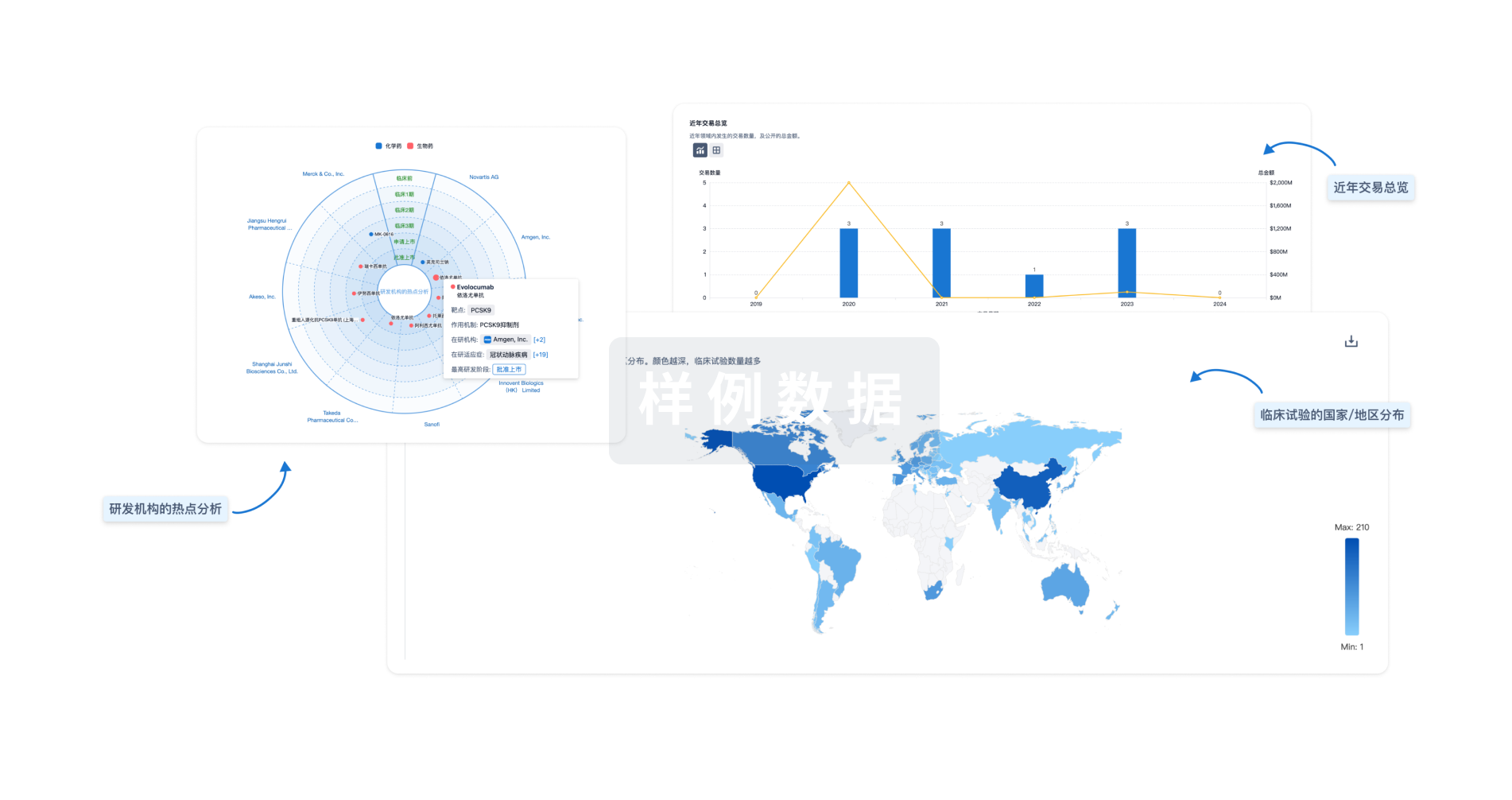预约演示
更新于:2025-05-07
DNAJC5
更新于:2025-05-07
基本信息
别名 Ceroid-lipofuscinosis neuronal protein 4、CLN4、CSP + [7] |
简介 Acts as a general chaperone in regulated exocytosis (By similarity). Acts as a co-chaperone for the SNARE protein SNAP-25 (By similarity). Involved in the calcium-mediated control of a late stage of exocytosis (By similarity). May have an important role in presynaptic function. May be involved in calcium-dependent neurotransmitter release at nerve endings (By similarity). |
关联
100 项与 DNAJC5 相关的临床结果
登录后查看更多信息
100 项与 DNAJC5 相关的转化医学
登录后查看更多信息
0 项与 DNAJC5 相关的专利(医药)
登录后查看更多信息
2,111
项与 DNAJC5 相关的文献(医药)2025-12-31·Human Vaccines & Immunotherapeutics
Magnitude and durability of ProC6C-AlOH/Matrix-M
tm
vaccine-induced malaria transmission-blocking antibodies in Burkinabe adults from a Phase 1 randomized trial
Article
作者: Addo Ofori, Ebenezer ; Plieskatt, Jordan ; Miura, Kazutoyo ; Theisen, Michael ; Tiono, Alfred B. ; Sagara, Issaka ; Long, Carole ; Naghizadeh, Mohammad
2025-05-01·International Journal of Biological Macromolecules
Exploring the impact of respiration on pectin metabolism through a quantitative respiratory system created by equilibrium modified atmosphere packaging with adjustable gas-conductor materials
Article
作者: Dong, Hao ; Yang, Xingfen ; Liu, Kun ; Wang, Wenxia ; Pan, Jialiang ; Wu, Ying ; Wu, Weiliang ; He, Qi ; Liao, Wenzhen ; Liu, Chunlong
2025-05-01·International Journal of Biological Macromolecules
Multi-omics analysis provided insights into the fruit softening of postharvest okra under carboxymethyl chitosan treatment
Article
作者: Wu, Xinye ; Wei, Lijuan ; Luo, Zhihong ; Liu, Changxin ; Shi, Yujie ; Chen, Mingrui ; Zhang, Qing ; Qin, Wen
15
项与 DNAJC5 相关的新闻(医药)2025-04-19
·微信
摘要:疟疾疫苗的研究历经多年取得了一定成果,RTS,S/AS01 和 R21/Matrix-M 先后获得 WHO 认可 。然而,受气候、政治、耐药性等因素影响,疟疾防控形势依旧严峻,疫苗研发和应用仍面临诸多挑战 。本文对近期疟疾疫苗的临床研究进展进行了综述,介绍了多种疫苗的特点、优势与不足,并探讨了未来研究方向,旨在为疟疾疫苗的进一步发展提供参考 。一、疟疾现状与疫苗研发的紧迫性疟疾是一种严重危害人类健康的传染病,近年来在流行国家的发病数量持续上升,2023 年全球 85 个地区估计有 2.63 亿病例 。部分地区,如中东,疟疾疫情出现显著反弹,一些原本无本地传播的国家也爆发了新疫情 。疟疾传播广泛,2022 年导致 60 多万人死亡 。这背后的主要原因包括气候变化、地缘政治不稳定以及寄生虫的耐药性和病媒对杀虫剂的抗性 。气候变化使气温和湿度上升,为蚊子滋生创造了更多机会,扩大了疟疾传播范围;地缘政治不稳定阻碍了公共卫生措施的实施,影响疫苗接种和病媒控制;寄生虫和蚊子的耐药性则削弱了现有治疗和预防手段的效果 。在这样的背景下,研发和推广有效的疟疾疫苗成为全球抗击疟疾的关键举措 。二、现有主要疟疾疫苗介绍RTS,S/AS01 疫苗:RTS,S/AS01 疫苗(Mosquirix)是全球首款获得 WHO 认可的疟疾疫苗 。它于 1987 年由葛兰素史克公司和沃尔特・里德陆军研究所联合研发,以恶性疟原虫环子孢子蛋白(CSP)的片段与乙肝表面抗原(HBsAg)融合为基础,搭配 AS01 佐剂,旨在预防疟疾感染的早期红细胞前期阶段 。三期临床试验显示,该疫苗在 5 - 17 个月大儿童中,可使疟疾临床发病率降低 36%;在 6 - 12 周龄婴儿中,降低 25.9% 。不过,其疗效未达 WHO 预期的 90%,且需在 14 个月内接种 4 剂,在疟疾流行地区,这对疫苗接种的依从性是个巨大挑战 。R21/Matrix-M 疫苗:2023 年,R21/Matrix-M 疫苗获得 WHO 批准使用和分发 。这款疫苗同样使用恶性疟原虫 CSP 片段与 HBsAg 结合,但 CSP 与 HBsAg 的比例是 RTS,S/AS01 的 5 倍,并采用了诺瓦瓦克斯公司研发的 Matrix-M 佐剂 。在非洲进行的三期临床试验表明,在季节性传播地区,该疫苗 18 个月内可将疟疾发病率降低 75%;在全年有疟疾传播的地区,12 个月内降低 68% 。R21/Matrix-M 疫苗生产成本较低,可大规模生产,安全性也较好 。但它也需要在 14 个月内接种 3 剂及 1 剂加强针,这可能影响高风险社区的疫苗全面覆盖,其长期安全性和对疾病负担的影响还需在四期监测中进一步确认 。目前,这两款疫苗尚未进行头对头比较,且初期研究差异较大,难以直接对比 。三、其他疟疾疫苗的研究进展全孢子体疫苗:全孢子体疫苗,如经辐射或化学减毒的 PfSPZ 疫苗以及基因工程减毒的 GA2 疫苗,在临床试验中展现出一定潜力 。其中,GA2 疫苗在早期试验中表现出色,单剂接种后 6 周内有效率达 90%,按疗程接种 3 剂后 3 周内有效率达 89% 。全孢子体疫苗的优势在于能诱导针对其他红细胞前期抗原的免疫反应,对异源恶性疟原虫菌株有保护作用,这可能克服 RTS,S/AS01 和 R21/Matrix-M 疫苗的局限性 。然而,这类疫苗需要液氮储存,给运输和储存带来了很大困难 。以血液阶段抗原为靶点的疫苗:疟原虫生命周期的血液阶段也是疫苗研发的重要靶点,旨在降低疾病严重程度和清除逃过前期免疫的残留寄生虫 。例如,针对网织红细胞结合蛋白同源物 5(RH5)的 RH5.1/Matrix-M 疫苗,已完成一期临床试验,显示出可接受的安全性和反应原性 。在布基纳法索进行的二期 b 试验中,该疫苗在 5 - 17 个月大儿童中,6 个月内有效率达 55%,这是血液阶段疫苗首次在疟疾传播现场研究中显示出疗效 。此外,还有针对裂殖子相关抗原(如 AMA-1、MSP1,2,3)的疫苗,但现场试验结果不理想,阻碍了这类疫苗的进一步研究 。传播阻断疫苗及其他创新疫苗:传播阻断疫苗针对疟原虫在人和蚊子体内的有性阶段,可阻止疟原虫进入蚊子唾液腺,从而中断传播,与针对肝脏阶段和血液阶段的疫苗联合使用,有望增强疟疾根除效果 。近年来,随着新冠 mRNA 疫苗的成功研发,mRNA 技术在疟疾疫苗领域也备受关注,一些针对 CSP 和其他抗原的 mRNA 疫苗已进入早期试验阶段 。另外,还有工程化单克隆抗体(如 CIS43LS)、针对孕期疟疾的 PAMVAC 和 PRIMVAC 疫苗等创新型疫苗也在研究中,部分已显示出可接受的安全性和免疫原性 。(原文 Fig. 1,展示疟疾疫苗在寄生虫生命周期不同阶段的靶点,帮助读者理解各类疫苗的作用机制)四、疟疾疫苗研究面临的挑战与未来方向尽管疟疾疫苗研究取得了不少进展,但仍面临诸多挑战 。不同类型的疫苗在非流行地区人群中的疗效普遍高于流行地区,这可能与寄生虫多态性以及流行地区人群体内存在免疫抑制性调节 T 细胞有关 。此外,目前的疫苗大多需要多次接种,接种程序复杂,影响了疫苗的全面覆盖 。未来,疟疾疫苗的研究应注重提高疫苗保护的持久性,简化免疫接种程序 。在抗原选择上,不应仅仅扩大范围,而要更注重靶向多个保守的 B/T 细胞表位,避开高度可变和多态的免疫显性区域,以增强疫苗的特异性 。同时,要加强对 T 效应细胞和中枢记忆 T 细胞免疫的研究,完善短期和长期保护性免疫的相关指标 。鉴于恶性疟原虫和间日疟原虫存在一些保守抗原,开发跨物种疫苗也是未来的一个重要研究方向 。识别微信二维码,添加生物制品圈小编,符合条件者即可加入生物制品微信群!请注明:姓名+研究方向!版权声明本公众号所有转载文章系出于传递更多信息之目的,且明确注明来源和作者,不希望被转载的媒体或个人可与我们联系(cbplib@163.com),我们将立即进行删除处理。所有文章仅代表作者观不本站。
疫苗临床3期信使RNA
2024-10-26
摘要:疫苗是公共卫生的重要工具,在减轻人群中传染病负担方面发挥着重要作用。新出现的传染病和疫情对疫苗开发提出了新的挑战,这要求在有限的资源下迅速设计和生产出安全有效的疫苗。在这里,我们关注从传统的预防性疫苗到针对慢性疾病和癌症的治疗性疫苗的广泛领域的疫苗开发,提供了八种不同疫苗形式(减毒活疫苗、灭活疫苗、多糖和多糖结合疫苗、重组亚单位疫苗、病毒样颗粒和纳米颗粒疫苗、多肽疫苗、DNA疫苗和mRNA疫苗)以及针对五种实体瘤(肺癌、乳腺癌、结直肠癌、肝癌和胃癌)、三种传染病(人类免疫缺陷病毒、乙型肝炎病毒和人乳头瘤病毒引起的疾病)和三种常见慢性疾病(高血压、糖尿病和血脂异常)的治疗性疫苗的最新进展的全面概述。我们旨在提供有关疫苗技术、平台、应用和潜在下一代预防性和治疗性疫苗技术的新的见解,为未来疫苗设计铺平道路。
1.引言
疫苗接种是保护易感人群和控制传染病最经济有效的手段。因此,疫苗被认为是20世纪十大公共卫生成就之一。疫苗的使用使人类能够在全世界范围内根除天花,消除大多数国家的脊髓灰质炎,并控制白喉、百日咳、破伤风、腮腺炎、麻疹、风疹、流感嗜血杆菌B型等传染病,在世界部分地区显著降低了发病率和死亡率。然而,由SARS-CoV-2引起的当前COVID-19大流行已导致超过5亿确诊病例和超过600万人死亡。新出现的传染病和疫情对疫苗开发提出了新的挑战,这要求在有限资源下迅速开发安全有效的疫苗。此外,包括人类免疫缺陷病毒(HIV)、呼吸道合胞病毒(RSV)、巨细胞病毒(CMV)、单纯疱疹病毒(HSV)和Epstein-Barr病毒(EBV)在内的几种由传染性病原体引起的严重疾病尚未开发出疫苗,需要新的疫苗开发策略。总的来说,疫苗使人们能够过上更健康、更长寿的生活。然而,随着预期寿命的增加,非传染性疾病(NCDs)的负担,如癌症、自身免疫疾病、高血压、动脉粥样硬化和糖尿病等,已经增加。NCDs,也称为慢性疾病,是由遗传疾病以及生理、环境和生活方式因素的组合引起的,并且可以持续很长时间。根据世界卫生组织报告,每年有4100万人死于NCDs,占全球死亡人数的71%。这种疾病负担的转变加剧了治疗NCDs的疗法的迫切需求。传统的预防性疫苗通过向健康个体接种抗原来预防疾病,从而建立特异性免疫,这主要发生在传染病上。治疗性疫苗用作暴露后治疗,以增强免疫系统对抗诸如慢性感染、癌前病变或癌症等先前存在的疾病。治疗性疫苗旨在调节人体免疫系统,并诱导细胞介导的免疫反应,以针对与NCDs相关的细胞或分子,而不是病原体或病原体感染的细胞。治疗性疫苗与预防性疫苗在一些重要方面有所不同。由于预防性疫苗通常给予健康人,这些人对不良事件的容忍度很低。相比之下,治疗性疫苗通常是暴露后治疗,并且患者高度耐受。成熟的传统疫苗和快速增长的新型疫苗技术促进了全球预防性和治疗性疫苗的开发。近年来,免疫学、分子生物学和基因组学的进步导致了更有效的疫苗成功。mRNA疫苗(Comirnaty、Spikevax、AWcorna)和病毒载体疫苗(Convidecia、AZD1222、Ad26.COV2.S)针对COVID-19大流行,是有史以来开发最快的疫苗。肺炎球菌多糖-蛋白结合疫苗(Prevnar13、Prevnar 20)基于蛋白结合疫苗技术。人乳头瘤病毒(HPV)疫苗(Gardasil、Gardasil 9、Cervarix、Cecolin和Wozehui),基于基因工程技术设计,通过表达病毒样颗粒(VLP)预防与HPV相关的癌症。脑膜炎球菌B型疫苗(Trumenba、Bexsero)代表了从基因组到疫苗的“反向疫苗学”策略。最后,新型佐剂重组带状疱疹疫苗,Shingrix,扩大了免疫功能低下人群的免疫力。疫苗的不断发展提高了我们对免疫学和免疫基础的理解,针对NCDs的疫苗成为研究的新“热点”。目前,有前列腺癌疫苗(Provenge)、膀胱癌疫苗(TheraCys)、结肠癌疫苗(OncoVAX)、黑色素瘤疫苗(M-VAX和Melacine)、肾细胞癌疫苗(Oncophage)、肺癌疫苗(Racotumomab和CIMAvaxEGF)等。此外,治疗性疫苗在高血压、慢性乙型肝炎等疾病领域也取得了巨大进展。本综述旨在提供我们对最新疫苗技术、平台、应用和潜在下一代疫苗技术的当前进展和理解的概述。本综述将讨论预防性疫苗和治疗性疫苗。根据疫苗的成分,预防性疫苗可分为减毒活疫苗、灭活疫苗、多糖和多糖结合疫苗、重组亚单位疫苗、多肽疫苗、DNA和mRNA疫苗。此外,根据疾病分类,治疗性疫苗可分为针对肿瘤的疫苗、针对传染病的疫苗和针对慢性疾病的疫苗。我们相信,本综述将为疫苗技术和开发提供见解。
2.预防性疫苗开发的进展
2.1.减毒活疫苗
减毒活疫苗是通过保留抗原性但通过化学或其他方法遗传工程改造或减毒(减弱)的有机体创建的。通常,这些疫苗能够诱导具有长期持久性的体液和细胞免疫反应;然而,仍然存在毒力逆转的风险,这使得疫苗不适合对抗高度致病性变体。此外,减毒疫苗的有效期较短,热稳定性差,对储存和运输有严格的要求;这在大流行情况下会导致响应缓慢。由于减毒疫苗可能恢复到有毒形式,它们也可能在免疫功能低下的人中引起严重疾病。尽管存在这些问题,并且因为好处大于风险,减毒活疫苗仍然是疫苗开发中一个宝贵的平台。目前许可的减毒疫苗列表包括天花(牛痘)(ACAM2000)、麻疹、腮腺炎和风疹病毒(M-M-RII)、结核病(卡介苗(BCG))、霍乱(Vaxchora)、流感(FluMist)、登革热(Dengvaxia;四价)、轮状病毒(Rotarix)、水痘病毒、伤寒(Vivotif)、黄热病(YF-Vax)等等(表1)。
表1 中国目前许可的疫苗类型
根据世界卫生组织发布的一份文件(https://www.who.int/publications/m/item/draft-landscape-of-covid-19-candidate-vaccines),有两种减毒活COVID-19疫苗正在进行临床试验:由Codaenixin与印度血清研究所合作开发的COVI-VAC,以及由Meissa Vaccines,Inc.开发的MV-014-212。正在进行研究以提高减毒活疫苗的安全性并进一步减少其毒力;这通过增加复制保真度、通过密码子去优化以及通过病毒基因组的工程改造进行了测试。Vignuzzi等人试图利用通过增加复制保真度限制病毒种群多样性的观察,这可以显著降低组织嗜性和病毒致病性。结果表明,在动物感染模型中,具有减少遗传多样性的脊髓灰质炎病毒变种激发了保护性免疫反应。这种限制病毒准种群多样性为RNA病毒的稳定减毒疫苗工程提供了一种新方法。密码子对去优化(CPD)是另一种有效的病毒减毒策略,它利用次优密码子对来减毒重编码病毒。Groenke等人通过改变同步密码子的位置,在重编码基因组中增加了次优密码子对和CpG二核苷酸的数量。他们在流感A病毒上的研究显示,次优密码子对引起了减毒,而CpG二核苷酸比例的增加没有效果。此外,他们表明次优密码子对可以降低去优化密码子对mRNA的稳定性和翻译效率。因此,蛋白质产量的减少直接导致病毒减毒。最近,Trimpert等人构建了一个COVID-19候选减毒活疫苗,名为sCPD9,通过大规模编码SARS-CoV-2基因组(通过CPD方法修改),并在罗布罗夫斯基矮仓鼠中评估了疫苗的免疫原性和保护效果。作者表明,sCPD9的单次鼻内接种激发了针对当前四个SARS-CoV-2变体的交叉中和抗体反应:B.1.1.7(阿尔法)、B.1.351(贝塔)、B.1.1.28.1(伽马)和B.1.617.2(德尔塔),保护免受类似COVID-19的疾病。一种减毒活COVID-19疫苗,COVI-VAC,通过使用同义次优密码子对编码病毒刺突蛋白的一部分而开发。作者发现,该疫苗在仓鼠模型中刺激了高水平的中和抗体,高度减毒的COVI-VAC在单次鼻内剂量下具有保护性。该疫苗现在正在进行III期临床试验(ISRCTN15779782)。安伯(amb)突变是使减毒活疫苗更安全、更有效的一种新策略。这种方法通过将遗传密码扩展到流感病毒基因组中,显示出在产生活体但复制无能力的病毒疫苗方面的前景。研究人员通过含有正交翻译机制的转基因细胞系扩展了流感A病毒基因组的遗传密码。这种方法在转基因细胞系中创建了早终止密码子(PTCs)——携带病毒足够具有感染力但在常规细胞中无法复制,同时在转基因细胞系中产生高繁殖力和遗传稳定的后代病毒。在小鼠、雪貂和豚鼠模型中,这种活疫苗激发了对亲本和抗原性不同的菌株的强大免疫反应。另一种有前景的基因工程减毒病毒的方法是工程化病毒基因组。研究人员报告了一种脊髓灰质炎病毒2型疫苗株(nOPV2)的开发,他们在其中引入了对Sabin2基因组的50个非翻译区域的修改,以稳定减毒决定因素。在这种方法中,2C编码区域防止重组,3D聚合酶限制了病毒的适应性。这种菌株在遗传上比原始的Sabin2菌株更稳定,不太可能恢复毒力。在临床前和临床研究中,nOPV2具有免疫原性,并可能导致脊髓灰质炎病毒的完全根除。另一组合理设计了一种减毒水痘疫苗候选物,v7D,其中删除了毒力因子ORF7。该病毒在MRC-5成纤维细胞和人类PBMC(VZV传播载体)中的复制类似于野生型病毒,但在感染人类皮肤和神经细胞时严重受损。然而,v7D在体外和各种小动物中具有与vOka相当的免疫原性。最后,v7D在非人类灵长类动物中耐受性良好且具有免疫原性。这种疫苗目前正在中国进行II期试验(ChiCTR1900022284)。未来减毒疫苗的开发应该专注于选择更稳定的病毒株,并采用基因编辑策略来稳定减毒因素。
2.2.灭活疫苗
灭活疫苗是从病原体(如病毒或细菌)的灭活形式中提取的,这些病原体经过培养后,通过物理或化学方法灭活,使其不再具有传染性或毒性。灭活疫苗包括全灭活疫苗或部分灭活疫苗(Toxoid疫苗)。Toxoid疫苗使用细菌产生的灭活毒素,这些毒素的毒性已被抑制,但保留了免疫原性。与减毒疫苗和基因工程疫苗相比,灭活疫苗具有开发周期短、生产工艺相对成熟、非传染性、高安全性等优点。灭活疫苗的生产成本通常较低,并且由于它们耐温,可以长时间储存。灭活疫苗通常诱导体液免疫反应,而细胞免疫较弱。通常需要多次接种才能产生保护性免疫,从而降低疫苗依从性。在灭活过程中,病毒抗原可能在结构上受损,导致抗原性降低,疫苗的免疫原性降低。有许多批准的灭活疫苗:代表性的例子包括甲型肝炎病毒疫苗(HAVRIX和VAQTA)、脊髓灰质炎病毒疫苗(IPOL)、日本脑炎病毒(IXIARO)疫苗、白喉和破伤风类毒素和无细胞百日咳(INFANRIX)疫苗、白喉和破伤风类毒素和无细胞百日咳吸附和灭活脊髓灰质炎病毒疫苗(KINRIX)疫苗、白喉和破伤风类毒素和无细胞百日咳疫苗吸附(DAPTACEL)疫苗、流感疫苗(Fluarix四价)、人类狂犬病疫苗(RabAvert和Imovax)、肠道病毒71型(Inlive)、肾综合征出血热疫苗、蜱传脑炎疫苗(FSME-Immun),以及COVID-19疫苗(CoronaVac、WIBP-CorV、BBIBP-Cor)(表1)。在撰写本文时,全球已有11种针对COVID-19疾病的灭活疫苗获得有条件或紧急使用批准(包括中国5种疫苗)。从其他病原体研究中,已开发出一种寨卡病毒灭活疫苗候选物(PIZV)。在两次免疫剂量后,含铝佐剂的候选PIZV在CD-1和AG129小鼠中显示出高度免疫原性,从而支持PIZV候选物进入临床开发(NCT03343626)。历史上,手足口病(HFMD)的爆发主要由肠道病毒71和柯萨奇病毒A16引起。最近,柯萨奇病毒A6和A10与全球散发HFMD病例和爆发的增加有关。在一项研究中,柯萨奇病毒A6、A10和A16(CA6、CA10和CA16)在不同条件下通过甲醛或b-丙内酯(BPL)灭活,并检查了免疫效果。作者发现,CA10和CA16在BPL灭活(BI)后的免疫效果优于甲醛处理。此外,双三价治疗诱导了足够的中和抗体和细胞介导的免疫反应,表明BI-CA6、CA10和CA16作为潜在的多价疫苗候选物。灭活疫苗平台相对成熟,高度安全,可用于快速应对新出现的病原体,因此对于应对爆发至关重要。
2.3.多糖和多糖-蛋白结合疫苗
多糖疫苗是由基于碳水化合物的聚合物制成的,如来自细菌病原体的荚膜结构的壁酸或肽聚糖。一些针对细菌荚膜多糖的疫苗,例如脑膜炎球菌A/C/Y/W-135疫苗(Meningune-A/C/Y/W-135)、肺炎球菌疫苗(Pneumovax 23)和伤寒Vi多糖疫苗(Typhim Vi)(表1),已被批准用于预防侵袭性脑膜炎和伤寒疾病。然而,由于多糖不像蛋白质那样在主要组织相容性复合体(MHC)分子上被处理和展示,多糖疫苗通常显示出较弱的免疫原性、持久性差,并且只产生T细胞非依赖性免疫反应。没有T细胞的参与,这些疫苗不会引起记忆免疫反应或亲和力成熟,并且诱导的抗体——主要是IgM和IgG2——不适合激活补体,导致免疫保护无效且短暂。
多糖结合疫苗可以克服多糖疫苗的缺点。多糖结合疫苗是通过将病原体的荚膜多糖共价连接到蛋白载体上制备的,例如白喉类毒素(DT)、破伤风类毒素(TT)、改良的白喉毒素称为CRM197、脑膜炎球菌外膜蛋白复合物(OMPC)或H. influenzae蛋白D HiD。蛋白载体和多糖同时出现在MHC-II上,导致T细胞受体(TCR)识别并激活Th反应。Th与B细胞之间的相互作用将改善和塑造抗体的滴度和质量以及B细胞记忆反应。共价结合方法包括标准化学交联和生物结合技术。目前批准的多糖结合疫苗通常是通过化学方法生产的,包括肺炎球菌13价、15价和20价结合疫苗(Prevnar 13, Vaxneuvance, Prevnar 20)、B型流感嗜血杆菌结合疫苗(Liquid PedvaxHIB, HIBERIX, ActHIB)和两种脑膜炎球菌结合疫苗(A, C, Y, W, MenQuadfi;A, C, Y和W-135, MENVEO, Menactra)(表1),等等。最近,Enotarpi等人报告了使用MenA,一种稳定的糖模拟结合疫苗,诱导针对A群脑膜炎奈瑟菌的保护性抗体。该团队生成了一系列未乙酰化的carbaMenA寡聚体,这些寡聚体被证明比荚膜多糖(CPS)更稳定,并表明八聚体(DP8)的随机O-乙酰化改善了抗MenA CPS抗体结合的抑制,并在与CRM197结合后诱导了抗MenA保护性小鼠抗体。这种方法可用于生成稳定的新糖结合疫苗。
生物结合技术允许多糖和载体蛋白在微生物内生物合成,通常是大肠杆菌。然后通过来自N-连接蛋白糖基化系统的特定寡糖转移酶在体内偶联蛋白质。近年来,生物合成因其经济性、快速性和效率而受到青睐。由这项技术生产的第一种多糖结合疫苗候选物是志贺氏菌多糖结合疫苗(GVXN SD133),由瑞士GlycoVaxyn AG开发,已完成I期临床试验(NCT01069471)。研究证明了GVXN SD133疫苗的良好安全性,所有测试剂量均能引起对志贺氏菌O1多糖的显著体液反应。蛋白载体也产生了功能性抗体,证明了这种新技术在保持碳水化合物和结合蛋白表位方面的优势。另一种针对志贺氏菌flexneri 2a(Flexyn2a)的生物结合疫苗在I期研究(NCT02388009)的所有时间点和所有组别中,接种后均引起了统计学上显著的S. flexneri 2a脂多糖(LPS)特异性体液反应。结果表明Flexyn2a具有令人满意的安全性,产生了强大的体液反应。这种疫苗目前正在进行IIb期(NCT02646371)。总体而言,多糖结合疫苗平台比其他平台显示出更多的潜力,并提供了解决细菌疫苗紧迫问题和挑战的解决方案,通过逐步使用生物合成技术。
2.4.重组亚单位疫苗
重组亚单位疫苗采用基因工程方法,在合适的宿主细胞中表达病原体特异性基因,如大肠杆菌、酵母、昆虫细胞或哺乳动物细胞等。重组亚单位疫苗通常具有良好的安全性和稳定性。然而,由于外源蛋白通常显示MHC II类反应,通常不会产生强烈的T细胞反应,因此需要佐剂刺激和多次接种以增强免疫原性,这可能不适用于呼吸道黏膜免疫。目前批准的人类重组亚单位蛋白疫苗包括流感疫苗(FluBlok)、带状疱疹疫苗(Shingrix)、脑膜炎球菌B群疫苗(Trumenba、Bexsero)和COVID-19疫苗(ZF2001、Nuvaxovid)(表1)。近年来,随着反向疫苗学、结构生物学、基因组学和蛋白质组学理论和技术的进步,重组亚单位疫苗免疫原逐渐进入理性设计的新时代。反向疫苗学的过程是利用自下而上的方法从基因组到疫苗开发疫苗。2013年批准的Bexsero脑膜炎B群疫苗是反向疫苗学的经典案例。它基于对致病微生物的关键保护或毒力抗原的全基因组预测和筛选,然后开发新疫苗;这样的例子包括三个抗原:淋病奈瑟菌肝素结合抗原(NHBA)、因子H结合蛋白(fHbp)和淋病奈瑟菌粘附素A(NadA)。Shingrix是葛兰素史克开发的重组亚单位佐剂疫苗,由水痘-带状疱疹病毒的糖蛋白gE重组蛋白组成,并补充了新的佐剂AS01B。对带状疱疹的整体疫苗效力在老年人(≥50岁)中为97.2%。Shingrix的成功强调了佐剂在疫苗开发中的关键作用。NVXCoV2373(Nuvaxovid)是一种含有昆虫细胞表达的S-三聚体和Matrix-M佐剂的重组蛋白疫苗。最近的临床结果显示,该疫苗对任何关注或感兴趣的变体的疫苗效力为92.6%。结核病亚单位疫苗M72/AS01E(葛兰素史克)包含两个M72重组融合免疫原(MTB32A和MTB39A)与佐剂系统AS01E结合,并为M. tuberculosis感染、HIV阴性成年人提供约50%的疾病进展到活动性肺结核的保护约3年。此外,另一种重组亚单位结核病疫苗(GamTBvac)被证明由两个结核分枝杆菌抗原融合(Ag85A和ESAT6-CFP10)组成,与明胶结合域固定在明胶上,并与由DEAE-明胶核心和CpG寡脱氧核苷酸(TLR9激动剂)组成的佐剂混合。II期的结果显示出有希望的安全性和耐受性,诱导了抗原特异性干扰素-γ反应、表达Th1细胞因子的CD4+ T细胞和IgG反应。结构生物学也有助于疫苗的理性设计。RSV表面融合(F)蛋白存在于两种构象中:前融合(pre-F)和后融合(post-F)构象。基于前F和抗体的高分辨率复合物结构,F蛋白被修改以在前融合状态下稳定(DS-Cav1)。I期临床显示,针对前融合特异性表面RSV F的血清抗体的中和活性增加了10倍以上。其他人设计并获得了一种基于结构探究的稳定RBD-sc-dimer疫苗分子。RBD的C末端的N602残基与另一个RBD的N末端串联设计,提高了RBD二聚体的稳定性和中和抗体反应。根据官方报告,疫苗的III期临床数据显示,该疫苗对18岁及以上人群的任何严重程度的COVID-19的保护效力为81.43%(NCT04646590)。这些结果代表了基于结构的疫苗设计的临床证据,预示着精准疫苗学的新时代的曙光。重组亚单位疫苗平台具有技术优势,如安全性和效率,以及良好的稳定性和成熟的产业。然而,安全有效的佐剂对提高疫苗效力至关重要。结构生物学、反向疫苗学和新型佐剂的新技术将促进重组蛋白疫苗的设计。
2.5.病毒样颗粒和纳米颗粒疫苗
病毒样颗粒(VLPs)是由病毒结构蛋白自组装形成的纳米尺寸(20-200纳米)颗粒,它们的结构和免疫原性与天然病毒相似。VLPs不包含病毒遗传物质,因此可以模拟病毒抗原性而不具致病性。VLPs具有高度重复的抗原表位阵列,有利于被树突状细胞(DCs)吞噬并呈现给MHC I类和II类分子。它们可以激活身体,诱导强烈的细胞和体液免疫反应,使其成为疫苗开发的理想平台。目前批准的VLPs疫苗包括乙型肝炎疫苗(Hepavax-B、Engerix-B、Recombivax HB、HBVaxPro、Heplisav-B、Fendrix、Hepavax-Gene)、HPV疫苗(Cervarix、Gardasil、Gardasil 9、Cecolin和Wozehui)、乙型肝炎E疫苗(Hecolin)、疟疾疫苗(Mosquirix)和COVID-19疫苗(Covifenz)(表1)。此外,多种基于VLPs的预防性疫苗已进入临床试验阶段,主要针对诺如病毒、轮状病毒、BK多瘤病毒、狂犬病、RSV、HIV、流感病毒等。疟疾疫苗的研发仍然是一个巨大的挑战。GSK的科学家使用截短的环孢子蛋白(CSP)结合乙型肝炎表面抗原(HBsAg)生成名为RTS的蛋白质。然后,RTS与另一个游离的HBsAg在酵母细胞中共表达,生成RTS,S VLPs。然而,尽管RTS,S/AS01的三剂疫苗最初对临床疟疾具有一定的保护作用,但疫苗的效力随时间减弱,在高于平均水平的疟疾寄生虫暴露中效果较差。然而,RTS,S疫苗的开发大大提高了我们实现开发有效安全疟疾疫苗的长期目标的机会。最近,提出了VLPs的嵌合设计,以保护免受多型病原体的侵害。作者用系统发育上密切相关的环区域替换了HPV L1环区域。HPV33/58/52 VLPs的三型嵌合体在小鼠和非人灵长类动物中诱导的中和滴度与三种野生型VLPs混合物相当。作者目前正在开发基于这一策略的七种交叉疫苗,针对20种HPV变体。Medicago Inc.开发的一种基于植物的VLPs COVID-19疫苗最近在加拿大获得授权使用。该疫苗含有SARS-CoV-2刺突(S)蛋白(原始菌株)的VLPs以及AS03佐剂,显示出71%的效力,保护18至64岁的试验参与者(https://www.canada.ca/en/health-canada/services/drugs-health-products/covid19-industry/drugs-vaccines-treatments/vaccines/medicago.html)。
纳米颗粒疫苗(NPVs)使用纳米材料作为载体、链接器或免疫调节剂,通过物理或化学方法将特定抗原和佐剂连接起来。这种基于纳米载体的传递系统可以保护疫苗免于过早降解,提高其稳定性,并促进免疫原传递到抗原呈递细胞(APCs),特别是DCs。此外,纳米颗粒提供了合适的疫苗给药途径,并增强了具有缓慢释放特性的抗原摄取,从而产生强烈的体液、细胞和粘膜免疫反应。纳米颗粒可以来自脂质体、VLPs以及金属或非金属无机、聚合物和脂质。但与其他疫苗候选物一样,NPVs的生产充满了许多困难和挑战。例如,一些NPVs可能会引发系统性或局部炎症反应,而一些纳米材料会在细胞中积累,导致其在体内长期保留,可能导致血管血栓形成。此外,在生产和储存成本方面仍存在一些限制。
自组装蛋白支架也在疫苗开发中得到广泛应用;例如I53-50、铁蛋白、mi3和IMX313颗粒。I53-50是通过计算工程设计的双组分蛋白,可自组装成二十面体纳米颗粒。该系统已用于RSV、流感病毒和HIV疫苗的开发,这些I53-50疫苗候选物在动物模型中诱导了强烈的抗体反应。在COVID-19疫苗开发中,一种多价SARS-CoV-2刺突受体结合域纳米颗粒(RBD-NP)疫苗在小鼠中显示出保护作用,仅需一次免疫。这种RBD-NP疫苗在非人灵长类动物中引发了多样化的多克隆抗体反应,目前正在进行临床试验(NCT04742738,NCT05007951)。另一项研究展示了一种疫苗,该疫苗显示了SARS-CoV-2刺突蛋白的多个副本,以诱导强烈的中和抗体反应,从而提供对高剂量SARS-CoV-2挑战的保护。铁蛋白是一种天然蛋白笼,由24聚体结构组成,具有八个三重轴,可用于展示三聚体抗原,如流感血凝素(HA)或HIV Env蛋白。一种基于铁蛋白的疫苗候选物目前正在进行针对EBV(传染性单核细胞增多症、各种癌症和自身免疫疾病的原因)的I期临床试验(NCT04645147)。一些COVID-19疫苗也被设计为使用铁蛋白来展示RBD或刺突三聚体,形成纳米颗粒,这两种疫苗候选物在临床前研究中都显示出了提高的抗体反应。最后,mi3 NP是理性设计的i301纳米笼的突变形式,显示出比原始形式更高的产量、均匀性和稳定性。基于RBD的mi3疫苗可以诱导针对SARS-CoV-2变体和SARS-CoV的中和抗体。mi3已被用于开发流感、典型猪瘟和疟疾疫苗。通过遗传融合、标签/捕手组装或化学交联可以实现抗原到支架的展示。与基于蛋白质的纳米颗粒疫苗相关的主要挑战是在融合到或展示在支架上时保持抗原的结构构象。纳米颗粒疫苗是一个激动人心的平台,用于灵活的抗原展示,在疫苗开发中具有巨大的潜力。
2.6.病毒载体疫苗
病毒载体疫苗使用减毒病毒疫苗株或非复制病毒作为载体,有效地将抗原基因代码传递到宿主细胞核中以诱导免疫反应。病毒基因组可以稳定地接受大基因片段的插入并表达特定抗原,从而可以使用病毒载体技术开发多种疫苗。抗原可以精确合成、修改并针对宿主中的特定细胞。病毒载体诱导的身体反应类似于对自然感染的反应,导致强烈的体液和细胞免疫反应。病毒基础疫苗的主要关注点是针对载体的预先存在的免疫力,这削弱了疫苗引起的抗体诱导和T细胞反应。目前,许多病毒载体,如人类和黑猩猩腺病毒(Ad和ChAd)、水泡性口炎病毒(VSV)、改良的安卡拉牛痘病毒(MVA)、麻疹病毒(MV)、痘病毒、新城疫病毒(NDV)和其他病毒已被用作疫苗开发的载体。批准的病毒载体疫苗包括埃博拉病毒疫苗和COVID-19疫苗。由CanSino Biotechnology, Inc.开发的首个获得许可的埃博拉病毒疫苗基于腺病毒(Ad5)载体,已获得国家药品监督管理局(NMPA)的批准(表1)。其他包括由Merck开发并由食品药品监督管理局(FDA)批准的复制能力VSV基础埃博拉疫苗ERVEBO;由Janssen Cilag International N.V.(Janssen)开发的编码扎伊尔埃博拉病毒糖蛋白的腺病毒Ad26,Zabdeno;Mvabea,一种MVA,编码扎伊尔埃博拉病毒、苏丹埃博拉病毒和马尔堡病毒的糖蛋白,以及由Janssen开发的Tai Forest埃博拉病毒的核蛋白。迄今为止,已有五种批准的病毒载体COVID-19疫苗:由CanSino开发的基于腺病毒载体的Ad5;基于重组ChAdOx1腺病毒载体(ChAd)平台的AZD1222(Vaxzevria),由AstraZeneca开发;由印度血清研究所有限公司开发的Covishield(ChAdOx1_nCoV-19);由Janssen开发的Ad26.CoV2.S疫苗;以及基于Ad26和Ad5载体的Sputnik V,由俄罗斯加马利亚研究所开发。
中国疾病预防控制中心(中国疾控中心)已开发出一种基于DNA疫苗与复制能力天坛牛痘(rTV)疫苗结合的HIV疫苗(DNA/rTV),该疫苗包含gag、pol和env基因。这种疫苗在恒河猴中对同源和异源挑战后的病毒获取具有保护作用。DNA/rTV疫苗在I期(ChiCTR-PRC-10001287)中安全并诱导免疫反应。2021年11月,使用DNA/rTV疫苗的II期临床试验(ChiCTR1900021422)已完成。研究人员还构建了一种包含刺突蛋白的复制能力重组病毒(rVSV-SARS-CoV-2)的COVID-19疫苗。结果显示,通过鼻内(i.n.)给药的rVSV-SARS-CoV-2疫苗在猕猴中诱发的中和抗体水平是肌肉注射(i.m.)途径的8倍。同样,基于NS1-del基础的减毒流感病毒载体的结核病疫苗也已进入I期临床试验(NCT03017378)。厦门大学、香港大学和北京万泰生物药业开发了一种基于减毒流感病毒的COVID-19疫苗,DelNS1-2019-nCoVRBD-OPT1(鼻内流感基础-RBD),目前正在进行III期临床试验(ChiCTR2100051391)。
由于其制造平台的多功能性和在流行病或大流行期间的响应时间,病毒载体疫苗越来越多地用于预防性疫苗的生产。然而,罕见的风险事件仍然是一个需要解决的重要问题,以充分利用这一平台在未来的潜力,这在传染病和癌症中具有重要意义。
2.7.肽疫苗
免疫系统对抗原作出反应,通常集中在少数氨基酸(aa)或肽段上,主要是B细胞和T细胞表位。肽疫苗旨在识别病原体上的肽序列,这些序列能够诱导保护性免疫反应,然后使用这些肽序列来全合成疫苗物质。由于它们是合成的,没有突变或逆转的风险,肽抗原可以快速修改以产生特定的反应。然而,这种方法在实践和理论上仍然存在困难。肽疫苗本身通常免疫原性不足,需要多次免疫才能有效。免疫原性可以通过将表位肽与载体蛋白融合、将表位肽与载体蛋白化学链接或人工合成相关肽的重复序列来增强。表位通常不是简单的氨基酸序列;然而,结构表位——具有精确构象——有时可能是抗体结合所必需和充分的。因此,以构象依赖的方式呈现肽是肽疫苗设计的重要考虑因素。先进的肽疫苗目前正在临床试验中,包括针对流感病毒、丙型肝炎病毒、HIV-1、疟疾和阿尔茨海默病的疫苗。
最近,图宾根大学医院开发了一种基于肽的COVID-19疫苗候选物,名为CoVac-1,由来自SARS-CoV-2的多个病毒蛋白(刺突、核衣壳、膜、包膜和开放阅读框8(ORF8))的T细胞表位组成。这与Toll样受体1/2激动剂XS15结合,在Montanide ISA51 VG中乳化。在I期,开放标签试验(NCT04546841)中,CoVac-1显示出有利的安全性,并且在所有参与者中诱导了针对多种疫苗肽的SARS-CoV-2特异性T细胞反应,由多功能Th1 CD4+和CD8+ T细胞介导。这些发现表明CoVac-1诱导了一种广泛、强大且与关注变体无关的T细胞反应。
一种疟疾疫苗PEV3B含有来自恶性疟原虫顶端膜抗原1(AMA-1)和环孢子蛋白(CSP)的两个多肽。临床试验Ia(NCT00400101)和Ib(NCT00513669)阶段证明了病毒体配方的PEV3B的安全性和免疫原性。事实上,在大多数时间点上,AMA-1和CSP肽抗原特异性IgG滴度显著高于对照组。这些发现为进一步开发针对疟疾的多价病毒肽疫苗提供了坚实的基础。
一种新型通用流感疫苗Multimeric-001(M-001),由BiondVax Pharmaceuticals Ltd.开发,包含来自A型和B型流感病毒的HA、NP和M1蛋白的保守表位,旨在保护免受多株和多季节流感病毒株的侵害。七个已完成的临床试验表明,该疫苗安全、耐受性好,并对广泛的流感毒株具有免疫原性。然而,在2020年10月,M-001的III期临床试验(NCT03450915)并未显示安慰剂组和接种组在减少流感疾病方面有显著差异。在HIV疫苗研究中,一种融合肽(FP)共价链接到关键孔虫血蓝蛋白(KLH)的赖氨酸残基上,命名为FP-KLH,被设计为在Env三聚体初次免疫后作为增强剂。这种组合免疫方案在小鼠中诱发了单克隆抗体,中和了高达31%的208种HIV-1跨亚型菌株。对豚鼠和猕猴的免疫诱导了类似的广泛的融合肽导向的中和反应,表明HIV-1融合肽是疫苗诱导广泛中和抗体的靶标。
肽疫苗的开发作为一种方法吸引了各种治疗领域的关注,包括癌症、阿尔茨海默病和丙型肝炎病毒。尽管如此,肽疫苗仍然存在挑战,包括较弱的免疫原性和不一致的免疫反应,这应该通过表位设计、载体优化和新佐剂的结合进一步改进和发展。
2.8.DNA和mRNA疫苗
核酸疫苗由DNA疫苗和mRNA疫苗组成。DNA疫苗使用编码蛋白质的细菌质粒,在哺乳动物启动子下,然后驱动宿主细胞中的抗原表达。DNA疫苗可以诱导体液和细胞免疫,具有长期免疫反应,并且易于制造和扩大规模。针对流感、乙型肝炎、HIV、疟疾、SARS-CoV-2和癌症等传染性和非传染性疾病的DNA疫苗已在数百项人类临床试验中进行了测试。最近,印度在2022年批准了第一种用于人类紧急使用的DNA疫苗。由Zydus Cadila开发的ZyCoV-D疫苗采用了非复制和非整合的质粒DNA,携带SARS-CoV-2的基因。ZyCoV-D使用无针系统,将免疫以狭窄的流体流形式传递到皮肤中,显著减少了副作用。在III期临床试验的中期报告中,ZyCoV-D疫苗的有效性达到了约66.6%。治疗组中诱发的不良事件的发生相似。总的来说,ZyCoV-D疫苗在III期试验中被验证为有效、安全和具有免疫原性。然而,许多DNA疫苗的免疫原性低于其他疫苗平台,并且与在其他哺乳动物中看到的临床结果相比,临床结果令人失望。此外,安全性问题,如质粒DNA整合到基因组DNA中。过去对DNA疫苗整合进行了广泛研究,但没有证据表明发生了整合。DNA疫苗受到其较弱的免疫原性的限制,需要施用更大的剂量。此外,它们有效的递送仍然是未来研究的问题。
mRNA疫苗通过将与病原体特定蛋白相对应的信使RNA(mRNA)引入宿主细胞而发挥作用。mRNA疫苗主要包括传统的非复制型mRNA和自复制mRNA(SAM)。获得许可的COVID-19疫苗BNT162b2和mRNA-1273都是非复制型mRNA疫苗。自复制RNA(SAM)具有编码RNA复制因子的完整基因。与传统mRNA相比,SAM具有更持久和更高水平的抗原表达。SAM疫苗所需的剂量也远低于传统mRNA疫苗。非复制型和SAM疫苗在引入细胞质时表达高水平的异源基因。mRNA疫苗可以激活先天免疫系统并发挥固有的佐剂效应。mRNA疫苗具有免疫原性;被模式识别受体(PRRs)如TLR3和TLR7/8识别;在接种部位产生细胞因子;并招募和驱动先天免疫细胞(如树突状细胞和巨噬细胞)的激活和成熟。对于适应性免疫,mRNA的翻译过程在细胞质中完成以产生目标抗原,然后被有效加工成多肽并呈现给MHC-I分子,引发细胞毒性T淋巴细胞(CTL)反应。翻译后的抗原随后被分泌并在MHC-II蛋白上呈现给辅助T细胞(Th),以引发CD4+ T细胞反应,这通过炎症细胞因子刺激B细胞产生中和抗体并激活吞噬细胞。与传统疫苗类似,为了克服脂质双层并将mRNA疫苗转移到细胞质中,已开发了各种mRNA疫苗的递送方法,包括基因枪、电穿孔、脂质纳米颗粒(LNPs)等。
COVID-19 mRNA疫苗Comirnaty(BioNTech/Pfizer)是FDA于2021年8月首次批准用于人类的mRNA药物;Spikevax(Moderna)疫苗也于2022年1月在美国获得授权,并随后在其他国家使用(表1)。Comirnaty和SpikeVax是LNP配方的、修饰核苷的mRNA疫苗,编码SARS-CoV-2的S蛋白的前融合稳定形式。在一项涉及43,548名参与者的研究中,接种两剂疫苗后BNT162b2预防COVID-19的有效性为95%。严重不良事件的发生率很低,疫苗组和安慰剂组之间相似。在涉及30,420名志愿者的III期临床试验中,mRNA-1273疫苗预防COVID-19的有效性为94.1%,同样,严重不良事件很少见。另一种mRNA疫苗(CVnCoV),由CureVac开发,已进入IIb/III期临床试验。然而,CVnCoV对有症状的COVID-19的有效性为48.2%,随着SARS-CoV-2变种的出现,该试验被暂停。另一种mRNA疫苗ARCoV,由中国的Walvax Biotechnology开发,已于2022年9月获得印尼药品机构的紧急使用授权。ARCoV热稳定,可在室温下至少存放一周。ARCoV在I期临床研究中被证明是安全且耐受性良好,并能诱导强大的体液和细胞免疫反应,支持进一步的大规模临床研究和人类使用。
目前,有超过25种针对SARS-CoV-2的mRNA疫苗候选物正在进行临床试验。此外,还有许多针对其他传染病的mRNA疫苗的临床试验,包括寨卡病毒(NCT04064905)、流感病毒(NCT03345043, NCT03345043)、巨细胞病毒(NCT04232280, NCT03382405, NCT03382405)、RSV(NCT04528719)、基孔肯雅病毒(NCT03829384, NCT03325075)和狂犬病(NCT02241135, NCT04062669)。
环状mRNA(circRNA)是一种非编码单链RNA,通过添加内部核糖体进入位点(IRES)和/或通过在5′UTR中纳入特定的核苷修饰,可以实现蛋白表达。这一新平台已被证明由于转录本的延长半衰期,在真核细胞中产生强大且稳定的翻译。最近,Qu等人报告了一种SARS-CoV-2 Omicron circRNA疫苗,该疫苗在小鼠和猴子中诱导了强大的体液和细胞免疫反应,并有效抵抗SARS-CoV-2。
与传统疫苗相比,mRNA疫苗具有类似活病毒的免疫反应机制,没有感染或整合到宿主基因组的风险,更稳定,能够有效表达抗原蛋白,并且通过快速且成本效益高的大型生产过程生产。从理论上讲,mRNA疫苗的开发只需要在成熟的技术平台上替换抗原序列;因此,在预防和控制新出现的传染病方面提供了相当大的优势。然而,mRNA疫苗在翻译效率和稳定性方面仍然存在一些挑战。此外,了解安全性和抗体反应的持续时间需要更长期的数据。总体而言,mRNA技术为疫苗、治疗以及更多领域提供了一个令人兴奋和有希望的途径。
2.9.当前和未来的中国预防性疫苗市场
中国是目前少数几个能够通过其工业基础设施提供足够疫苗供应能力的国家之一。近年来,中国在疫苗研发方面做出了巨大努力,并取得了显著进展,其疫苗市场正逐渐繁荣起来。根据NMPA批准的药品信息,中国市场上有94种预防性疫苗,可以预防38种疾病(表2)。其中,80种疫苗是国内生产的,11种来自国外;国产疫苗作为市场的主力,而一些战略性疫苗的供应,如白喉、破伤风、百日咳、脊髓灰质炎和b型流感嗜血杆菌联合疫苗(DTwP/Hib)、五价轮状病毒疫苗、四价和九价HPV疫苗以及带状疱疹疫苗仍然依赖外部制造商。最近,国产HPV疫苗和肺炎球菌疫苗的批准展示了中国在疫苗开发和制造领域的巨大潜力。中国还开发了手足口病疫苗(EV71)、戊型肝炎疫苗和埃博拉疫苗等新型疫苗。这些成就为SARS-CoV-2出现后多技术疫苗突破的快速部署奠定了坚实的基础。目前中国市场上的传染病疫苗包括流感、水痘、脑膜炎球菌性脑膜炎、甲型肝炎、乙型肝炎、戊型肝炎、狂犬病、白喉、百日咳、破伤风、b型流感嗜血杆菌、脊髓灰质炎、结核病、霍乱、轮状病毒、脓疱疮、气管炎、手足口病、破伤风、伤寒、副伤寒、黄热病、钩端螺旋体病、蜱传脑炎、日本脑炎、麻疹、腮腺炎、风疹、鼠疫、肺炎球菌肺炎、炭疽、布鲁氏菌病、COVID-19、宫颈癌、细菌性痢疾、埃博拉出血热、肾综合征出血热、带状疱疹。然而,与全球市场相比,中国仍然缺乏一些疾病的疫苗,如登革热、B群脑膜炎球菌和疟疾。同时,值得注意的是,中国大多数疫苗目前基于传统疫苗平台,如灭活或减毒活疫苗、基因工程疫苗。第三代疫苗技术如病毒载体和核酸疫苗的开发才刚刚开始,中国市场上还没有核酸疫苗。
表2 中国当前许可的疫苗市场
对于重要疾病,如HIV、RSV、寨卡病毒和巨细胞病毒疫苗,尚未在全球成功开发和上市。此外,主要传染病病原体的其他亚型或突变逃逸株也在不断演变。因此,带来了许多挑战,如现有疫苗覆盖不足,如COVID-19、流感、结核病等疫苗。此外,一些现有的传染病疫苗对某些特定类型预防效果较差,如B群脑膜炎球菌疫苗、人类乳头瘤病毒疫苗、肠道病毒EVD68、超级细菌疫苗等。此外,中国无法独立满足高风险或特殊人群的疫苗需求,如老年人的带状疱疹疫苗。最后,联合疫苗是一线可以预防多种疾病并让人们通过较少的注射获得保护的疫苗。未来,应加强新一代疫苗技术的开发,如病毒载体疫苗和核酸疫苗。
3.治疗性疫苗的发展进展
与预防性疫苗不同,治疗性疫苗是指在已经感染病原体或患有特定疾病的患者中诱导特异性或非特异性免疫反应以治疗疾病进展的生物制品。因此,治疗性疫苗的主要目标是诱导肿瘤消退、根除微小残留病、建立持久的抗肿瘤记忆以及避免非特异性或不良反应。治疗性疫苗主要分为四类:基于肽/蛋白的疫苗、基于细胞的疫苗、基于DNA或RNA的疫苗和基于病毒载体的疫苗。根据疾病分类,治疗性疫苗可以分为针对肿瘤的疫苗、针对传染病的疫苗和针对慢性病的疫苗。首个获得FDA批准的癌症疫苗,Sipuleucel-T(Provenge,由Dendreon公司商业化),目前用于治疗转移性去势抵抗性前列腺癌。Provenge是一种自体的、基于树突状细胞的疫苗,装载有与粒细胞-巨噬细胞集落刺激因子(GM-CSF)融合的前列腺酸性磷酸酶(PAP)抗原;这种疫苗首次实现了利用患者的自身免疫细胞攻击癌细胞的理念。迄今为止,已有超过30,000名男性患者接受了Provenge治疗,临床上已证明可以延长晚期疾病男性患者的生命。Provenge的批准在治疗性疫苗领域内具有重要意义,并强调了抗癌疫苗可以发挥作用的事实,从而为进一步投资癌症疫苗开发提供了动力。
3.1.治疗性疫苗在癌症方面的应用
3.1.1.治疗性疫苗在肺癌方面的应用
肺癌(LC)是最常被诊断出的癌症,也是导致癌症相关死亡的主要原因,由于预后不佳和临床结果差,给全球公共卫生带来了沉重负担,5年生存率为19%;实际上,肺癌占癌症总病例的11.4%,占全球癌症总死亡人数的18.0%。LC分为两个主要组织类型:小细胞肺癌(SCLC)和非小细胞肺癌(NSCLC)。传统的抗癌疗法(手术、放疗和化疗)在遏制进展方面的有效性有限,因此,全球范围内正在积极开展针对LC的治疗性疫苗设计研究(表3)。2008年,古巴开发了世界上第一个有效的治疗性疫苗CIMAvax EGF用于NSCLC,后来在古巴、秘鲁和委内瑞拉批准用于一线化疗后的晚期(IIIB和IV期)NSCLC治疗。CIMAvax EGF由人重组表皮生长因子(EGF)与脑膜炎奈瑟菌重组P64K蛋白共价结合而成。EGF调节细胞生长和分裂,NSCLC患者中EGF的过度表达与细胞生长和分裂失控有关。CIMAvax EGF通过刺激免疫系统产生特异性针对EGF的抗体,抑制其与癌细胞上的相应受体结合,从而减缓癌细胞的无控制生长。II期和III期临床试验表明,CIMAvax EGF耐受性良好,并延长患者生存期,特别是60岁以下患者的中位总生存期(OS)分别为18.53个月和7.55个月。另一种疫苗Vaxira是一种免疫治疗剂,由小鼠γ型抗异型单克隆抗体Racotumomab和氢氧化铝组成。Racotumomab特异性诱导针对在多种实体瘤中过度表达的Neu-糖基化GM3神经节苷脂(NeuGcGM3)的抗体反应。目前正在评估多种癌症适应症,包括黑色素瘤、乳腺癌和肺癌。Vaxira治疗NSCLC的临床试验结果显示,中位生存时间为8.23个月,略高于对照组的6.8个月;Vaxira治疗组的中位无进展生存时间为5.33个月,对照组为3.9个月,证明了Vaxira优于安慰剂。基于II/III期研究的有希望的结果,Racotumomab于2013年在古巴和阿根廷推出,作为晚期NSCLC患者的皮下注射治疗。Tedopi是一种基于新表位的疫苗,具有针对HLA-A2+的限制性修饰新表位,针对肺癌中经常表达的五种肿瘤相关抗原:CEA、HER2、MAGE2、MAGE3和P53。在II期试验中,Tedopi在预处理的晚期NSCLC患者中显示出17.3个月的OS,并具有可管理的安全性。ATALANTE-1——一项随机、开放标签、两步、III期研究——比较了Tedopi与标准治疗(SoC)在HLA-A2+ NSCLC患者中的疗效,这些患者在ICI治疗后疾病进展的第二或第三线治疗。Tedopi通过刺激杀手T细胞,使它们能够发现并消除癌细胞,这是治疗疾病的关键过程。结果显示,在63名Tedopi组患者中,有29名患者至少存活了12个月,12个月生存率为46%,远高于预定的25%。一名54岁的晚期LC患者,在接受了五次Tedopi注射后,肿瘤迅速缩小(从39毫米缩小到23毫米)。在本报告发布时,患者的生存期已超过20.6个月,仍在观察中。现在,由于其出色的临床数据,Tedopi已获得美国FDA的孤儿药指定,用于治疗HLA-A2阳性NSCLC。
表3 市场上或处于临床开发阶段的针对不同疾病的治疗性疫苗
3.1.2.治疗性疫苗在乳腺癌方面的应用
乳腺癌(BC)是全球第二常见的恶性肿瘤,每年有超过226万例新病例。它也是女性癌症相关死亡的主要原因。迄今为止,截至2021年6月23日,共有44项正在进行的(即活跃的、不招募;招募;尚未招募)临床试验正在研究BC的治疗性疫苗。就疫苗平台而言,大多数BC疫苗是基于肽的(N=20,45.5%),而大约有10项(22.7%)的临床试验正在测试基于细胞的BC疫苗;新技术开发的病毒载体疫苗占6项(13.6%),而基于基因的BC疫苗正在8项(18.2%)临床试验中进行评估。
人表皮生长因子受体-2(HER2)是乳腺癌疫苗的理想靶点,是一种细胞表面受体蛋白,具有酪氨酸激酶活性,在高达75%的BC中表达。HER2在细胞生长、存活和分化中发挥着极其重要的作用。针对HER2的基于肽的疫苗能够诱导持久的特异性细胞和体液免疫反应,以抑制HER2阳性肿瘤细胞的生长,显示出高免疫原性、强特异性和良好的安全性。在II期临床试验(NCT00524277)中,HER2衍生的肽疫苗GP2,即HER2跨膜域(TMD)的亚优势表位,与GM-CSF(一种FDA批准的免疫佐剂)结合使用。这种组合刺激了抗原呈递细胞(如DC等)的增殖,并进一步诱导CD8+细胞毒性T淋巴细胞(CTLs)识别和摧毁表达HER2/neu的癌细胞。此外,GP2疫苗耐受性良好,没有严重的不良反应,接受GP2疫苗治疗的BC患者在手术后以及Herceptin治疗后5年的无病生存率达到100%。此外,与单独接受GM-CSF治疗的患者相比,BC复发率为0%,而后者为89.4%。基于E75(HER2/neu 369-377,KIFGS LAFL)的疫苗是治疗BC患者最广泛研究的策略。然而,目前的结果表明,E75疫苗仅对三阴性BC患者并且在治疗与曲妥珠单抗联合使用时对表达HLA-A24的患者提供了显著的临床益处;需要进一步评估这些效果。其他基于肽的疫苗也在临床试验中(表3):AE37(HER2/Neu 776-790,GVGSPYVSRLLGICL;II期临床试验中),TPIV100(一种使用sargramostim作为佐剂的多表位疫苗,针对HER2;II期临床试验中),MVFHER-2(aa597-626;I期临床试验中)和MVF-HER-2(aa266-296;I期临床试验中)(MVF-HER2是两种嵌合型曲妥珠单抗样(MVF-HER2,aa597-626)和小扰素样(MVF-HER2,aa266-296)HER2 B细胞肽基疫苗的组合)。此外,基于细胞的治疗性疫苗是患者特定的,需要一种安全的方法进行个性化疫苗开发(Arab等人,2020年)。目前有多种针对HER2的基于细胞的疫苗正在开发中(表3):DC细胞(NCT02061423,NCT04348747),PBMC细胞(APC8024),以及同种异体细胞(NCT00847171)已被用作免疫原进行免疫。初步结果表明,这些疫苗耐受性良好,并提供了特异性抗HER2细胞免疫反应。目前,正在考虑用于提高BC治疗性疫苗效果的各种方法:包括选择合适的细胞亚群、佐剂的选择以及不同的工程方法(如基于VLP或基于基因的疫苗)。然而,这些优化的临床益处仍有待验证。
3.1.3.治疗性疫苗在结直肠癌方面的应用
结直肠癌(CRC)是世界上第三常见的癌症,仅次于LC和BC,发病率为10.0%,死亡率为9.4%。CRC的标准治疗是手术、化疗和放疗,这些治疗可能结合使用。然而,这些治疗有许多副作用,许多患者在一系列治疗后仍然会复发。因此,为这一患者群体开发替代的有效治疗方法至关重要。尽管,目前还没有FDA批准的CRC疫苗,但已评估了多种疫苗用于治疗CRC,包括自体、DC、肽和基于病毒载体的疫苗。OncoVAX是一种自体结肠癌疫苗,与活的卡介苗(BCG)混合,用作CRC切除术后患者的辅助治疗。III期临床试验(NCT02448173)结果表明,OncoVAX对III期结肠癌患者没有显著影响,但在平均5.8年的随访期间。OncoVAX显著延长了II期结直肠癌患者的无复发期,并降低了总体复发风险和死亡风险。作为一种主动特异性免疫治疗(ASI),OncoVAX在免疫调节佐剂(BCG)的帮助下增强了患者肿瘤细胞的免疫原性,以刺激患者对自体(患者特定)肿瘤细胞的免疫反应。基于ASI的治疗程序通常假定患者肿瘤细胞上存在不同的肿瘤抗原,并且这些抗原在正常细胞中不存在或浓度较低。
最近的研究报告了一种基于腺病毒的疫苗,用于治疗结直肠癌(CRC),并在I期临床试验(NCT01972737)中取得了积极结果。研究发现,CRC抗原鸟苷酸环化酶C(GUCY2C)能够在小鼠中引发针对肿瘤的抗原特异性CD8+ T细胞反应,而不是CD4+ T细胞,从而在不引起自身免疫的情况下提供抗肿瘤免疫。由人类5型腺病毒(Ad5)(作为载体)、PADRE(在大多数人类HLA分子背景下活跃的CD4+ T细胞表位)和GUCY2C组成的Ad5-GUCY2C-PADRE疫苗也经过了测试:在I/II期临床试验中,10名CRC患者接受了疫苗接种,并在6个月内进行了随访。作者发现Ad5-GUCY2C-PADRE安全地产生了针对抗原的细胞毒性CD8+细胞,但没有产生自身免疫性CD4+ T细胞,且没有严重的不良反应。
在2020年美国临床肿瘤学会(ASCO)大会上,梅奥诊所报告了一种新的治疗方法疫苗PolyPEPI1018,专门为MSS型CRC设计,可以有效延缓肿瘤进展。PolyPEPI1018是一种多肽疫苗,由六种合成肽组成。这些肽段包括来自7种保守的癌症睾丸抗原(CTAs)(TSP50、EpCAM、Survivin、CAGE1、SPAG9、MAGE-A8、FBXO39)的12个独特的免疫原性表位,这些抗原在mCRC中经常表达。这种疫苗经过优化,以诱导持久的CRC特异性T细胞反应。在OBERTO临床I/II期试验(NCT03391232)中,共有11名患者接受了PolyPEPI1018疫苗接种:3名患者进一步肿瘤进展,5名患者病情稳定,3名患者部分肿瘤缓解,2名患者的肿瘤缩小到可以接受手术的程度。值得注意的是,在手术后原发肿瘤中没有发现存活的肿瘤细胞,表明肿瘤细胞被杀死了。因此,这些初步发现表明PolyPEPI1018对MSS mCRC肿瘤具有早期临床活性,可以有效延缓肿瘤进展。因此,需要进一步研究以调查PolyPEPI1018的疗效。此外,还有多项旨在寻找正确的抗原刺激物的试验正在进行中。
3.1.4.治疗性疫苗在肝癌方面的应用
肝癌是全球最常见的癌症之一,发病率为4.7%,死亡率为8.3%。肝细胞癌(HCC)是最常见的原发性肝癌类型,通常发生在由酗酒、代谢综合征或乙型肝炎(HBV)或丙型肝炎(HCV)病毒感染引起的慢性肝病背景下。事实上,HBV和HCV感染被认为是HCC的主要风险因素。尽管HCC有各种治疗方法,包括预防性疫苗,包括HBV疫苗,已被报告可以降低HCC的发病率;尽管如此,患者总体生存率的变化仍然远未令人满意,对于更有效的治疗方法存在巨大的未满足需求。癌胚抗原糖蛋白-3(GPC3)在80%的HCC中特异性高表达,但不在正常组织中表达,因此被认为是抗原特异性免疫治疗的理想靶点。事实上,Nobuhiro等人已经发现GPC3肽可以在小鼠中诱导免疫反应,产生特异性细胞毒性T淋巴细胞(CTL)和抗肿瘤活性,而不会引发自身免疫现象。因此,大多数基于肽的HCC疫苗主要针对GPC3抗原。
在一项II期临床病例对照研究(UMIN-CTR,UMIN000002614)中,比较了接种和未接种GPC3肽疫苗的患者的无病生存(DFS)、总生存(OS)和CTL诱导。研究证实,无论是否接种GPC3肽疫苗,80%的患者都会复发。然而,术后辅助疫苗接种可能会使1年复发率降低约15%,5年和8年生存率分别提高约10%和30%。此外,GPC3 IHC染色阳性的患者更有可能诱导CTLs,60%的患者生存超过5年。另外两种肽鸡尾酒疫苗(ONO-7268MX1 [JapicCTI-121933]和ONO-7268MX2 [JapicCTI-142477]),包含GPC3、在HCC中上调的含有WD重复的蛋白(WDRPUH)和类似内切核酸酶VIII的三个表位(NEIL3),在两项I期研究中评估了晚期HCC。除了GPC3,WDRPUH和NEIL3也被确定为HCC中的潜在免疫治疗靶点。其中,WDRPUH具有促进生长的活性,抑制WDRPUH可以延缓癌细胞的生长,而NEIL3作为一种肿瘤抗原,其编码基因在HCC中表现出高频的杂合性丧失,表明它可能是一个潜在的肿瘤抑制基因,在DNA修复中发挥作用。接种ONO-7268MX1和ONO-7268MX2的HCC患者显示出良好的耐受性,并诱导了CTL反应。一些患者还表现出长期疾病控制,ONO-7268MX1和ONO-7268MX2的疾病控制率分别为52.9%和35.7%,报告了9名和5名患者的病情稳定。这些结果暗示了这些疫苗在治疗HCC方面的潜在用途。
IMA970A是一种由16种新发现的在HCC患者肿瘤组织中过度表达的肿瘤相关肽(TUMAPs)组成的基于肽的HCC疫苗。IMA970A与免疫刺激剂CV8102一起给药,可以诱导平衡的Th1/Th2免疫反应。在这些TUMAPs中,有7种限制在HLA-A02上,5种限制在HLA-A24上,4种限制在HLA-II类上。处于非常早期、早期和中期HCC的患者被纳入接受单次低剂量环磷酰胺的预疫苗输注,然后是9次皮内疫苗接种。初步结果显示疫苗具有良好的安全性,但免疫原性数据尚未公布(NCT03203005)。此外,甲胎蛋白(AFP)作为HCC最广泛使用的血清标志物,可以改善预后并用于监测治疗反应;AFP衍生肽疫苗的安全性和有效性也在临床试验中得到了验证。
另一种HCC的治疗性疫苗是基于个性化肽疫苗。2017年,一项I/II期研究评估了一种新的治疗方法对晚期HCC的疗效和安全性:基于个性化肽疫苗(PPV-DC-CTL)的细胞免疫治疗与放疗相结合。结果显示疫苗耐受性良好,未引起严重副作用,研究中的9名患者病情控制良好,有效率(RR)为33%,疾病控制率(DCR)为66%。治疗效果明显优于单独报告的经导管动脉化疗栓塞(TACE)、索拉非尼和化疗。另一种个性化肽疫苗是使用仅来自恶性肿瘤细胞的非同义突变表位肽作为抗原(称为新抗原);这些肽与MHC一起在肿瘤中表达,因此被T细胞特异性识别,引发强烈的抗肿瘤免疫反应。最近,刘团队发现个性化新抗原疫苗策略在预防HCC术后复发方面安全、可行且有效,并且通过ctDNA中的相应新抗原突变监测HCC进展也很有用;实际上,这为HCC患者的个性化医疗提供了可靠信息。在一项I期临床试验(ChiCTR1900020990)中,10名有血管侵犯的HCC患者在接受HCC诊断后2个月内进行了根治性手术切除和预防性TACE。通过肿瘤和周围组织全外显子测序鉴定非同义体细胞单核苷酸变异。对于疫苗,使用了6-20个体细胞点突变或RNA编辑新抗原长肽(27aa),并与ploy:IC佐剂混合作为抗HCC复发治疗。结果显示没有明显的治疗相关不良事件:新抗原疫苗可以有效地诱导和激活HCC患者的特异性免疫反应,并相应地延长这些患者的无复发生存期。患者的中位RFS为7.4个月,证实了个性化新抗原疫苗预防HCC患者术后复发的安全性和可行性。总之,我们讨论了几个涵盖癌症治疗肽疫苗的积极结果的例子,表明在人类中诱导CTLs是有希望的。但到目前为止,还没有观察到完全和明确的康复病例。需要进一步设计和筛选具有高免疫原性的有效的肽序列,辅以高效佐剂,或与其他免疫疗法结合,以实现更好的肿瘤消退。
3.1.5.治疗性疫苗在胃癌方面的应用
人们一直在推动研究癌症疫苗在各种肿瘤组中的作用,包括胃肠道癌症。胃癌(GC)是世界第五大癌症,2020年的发病率为5.6%,死亡率为7.7%。大多数GC患者在晚期被发现,局部晚期疾病或转移性扩散导致的不可切除病变的5年OS率仅为5%至15%。近年来,在免疫检查点抑制剂的治疗下,GC取得了巨大进展,但GC的治疗性疫苗仍处于临床阶段(表3)。因此,许多研究正在探索将免疫检查点抑制剂与化疗和其他药物或疫苗结合使用的潜力。例如,在之前的一项研究中,晚期GC患者接受了人类白细胞抗原(HLA)-A24限制性的人类血管内皮生长因子受体1(VEGFR1)-1084和VEGFR2-169多肽疫苗与S-1加顺铂的组合治疗,中位生存时间达到14.2个月。另一种选择,胃泌素-17-白喉毒素免疫原(G17DT;Gastrimmune),一种抗胃泌素17免疫原,已确认可以提高针对胃泌素17的高亲和力中和抗体,可以阻断胃泌素刺激的生长并抑制胃泌素与CCK-2受体的相互作用。G17DT现在已经在许多肿瘤治疗中用于被动和主动免疫治疗,包括原发性和转移性疾病。实际上,作者证实,当与5-氟尿嘧啶加顺铂结合使用时,G17DT可以刺激体内的免疫反应,并且有免疫反应的患者生存时间更长。
如上所述,肿瘤特异性抗原是免疫治疗的潜在靶点。通过比较GC样本和正常组织之间的差异蛋白表达研究,已经鉴定出四种癌症特异性抗原——FOXM1、DEPDC1、KIF20A和URLC10;这四种抗原在肺癌、食管癌、膀胱癌和其他癌症中也上调。
血管生成是肿瘤进展的关键机制,血管内皮生长因子(VEGF)是已知最有效和特异性最强的血管生成促进因子,因此,它被用作许多疫苗的靶点。OTSGC-A24是一种针对FOXM1、DEPDC1、KIF20A、URLC10和VEGFR1的HLA-A24:02结合肽疫苗混合物。在I/Ib期临床试验(NCT01227772)中,观察到24名携带HLA-A24:02单倍型的晚期胃癌患者的显著CTL反应,患者的总生存期为5.7个月(Sundar等人,2018年)。
除了肿瘤抗原,新抗原或识别新抗原的T细胞存在于大多数癌症中,为个性化疫苗设计提供了特异性和高度免疫原性的目标。I/II期临床试验(NCT03480152)评估了一种名为mRNA-4650的mRNA疫苗,该疫苗由多达20种不同的mRNA组成,编码定义的新抗原、驱动基因的突变和HLA-I预测的表位。在转移性胃肠道癌症患者中,疫苗被证明是安全的,并诱导了针对预测新表位的突变特异性T细胞反应,这些反应在疫苗接种前未被检测到。然而,尚未观察到客观的临床反应,疫苗可能只与其他免疫疗法结合使用以增强治疗效果。
最近,Ursula Wiedermann团队开发了一种治疗性B细胞表位疫苗(IMU-131/HER-Vaxx),并在Ib期临床试验(NCT02795988)中验证了其在HER2/neu过度表达的胃食管腺癌(GEA)患者中的免疫原性和有效性。IMU-131/HER-Vaxx由来自HER2/neu细胞外域的三个融合B细胞表位(P4、P6和P7)组成,与CRM197偶联,并用Montanide佐剂。针对IMU-131肽的抗体通过结合HER2受体的三个不同区域并参与二聚体环,阻止两个HER2受体的二聚体化,从而抑制细胞内信号传导。这种阻断HER2信号通路被认为比单独使用曲妥珠单抗更有效。相比之下,CRM197(CRM;交联材料),一种酶失活的非类毒素白喉毒素形式,已被成功用作各种疫苗的伴侣,可以快速激活具有异质性Th1和Th2细胞因子谱的CD4+ T细胞,用于激活B细胞和调节诱导抗体的数量。在大多数14名接种GEA患者中,检测到针对HER2的特异性抗体和T细胞反应,IMU-131显示出良好的耐受性和安全性。
3.2.治疗性疫苗在病毒性传染病方面的应用
3.2.1.治疗性疫苗在乙型肝炎病毒方面的应用
乙型肝炎病毒(HBV)属于Hepadnaviridae家族,是一种部分双链的包膜DNA病毒。如上所述,HBV感染是导致HCC的重要因素之一,但并非所有HBV感染都会发展成癌症。相反,由HBV引起的慢性乙型肝炎(CHB)对公共卫生的影响更大。尽管经过数十年的积极疫苗接种,全球有20亿人的乙型肝炎血清学特征,其中2.5亿人患有慢性乙型肝炎。目前,只有两种批准用于CHB的药物:核苷类似物和聚乙二醇干扰素(IFN),这两种药物在抑制病毒复制方面有效,但无法清除病毒基因组或从感染肝细胞的血清中清除HBV表面抗原(HBsAg)。因此,迫切需要探索新的治疗途径。目前,有2种治疗性疫苗(NASVAC和YIC)已完成III期临床试验。此外,还有3种疫苗已完成II期临床试验,其中2种(GS-4774和HB02 VAC-ADN)未达到主要终点,1种(εPA-44)达到了治疗终点并进入III期临床试验。还有3种治疗性疫苗(CVI-HBV-002、VBI-2601和HepTcell)处于II期临床试验中,许多处于I期临床试验中(表3)。
乙型肝炎病毒(HBV)衣壳主要由乙型肝炎表面抗原(HBsAg)、乙型肝炎核心抗原(HBcAg)、乙型肝炎e抗原(HBeAg)和HbxAg组成。目前,大多数HBV治疗性疫苗侧重于HBsAg和HBcAg作为主要免疫原。在一项III期临床试验中,对CHB的初治患者使用NASVAC进行治疗,NASVAC是一种包含HBsAg和HBcAg的治疗性疫苗。作者发现,在80名接受NASVAC疫苗接种的患者中,有85%的患者丙氨酸氨基转移酶(ALT)水平升高,并清除了HBeAg。另一项III期临床试验评估了一种含铝佐剂的治疗性乙型肝炎疫苗(YIC),由抗原(HBsAg)-抗体(HBIG[乙型肝炎免疫球蛋白])免疫复合物组成。本研究旨在通过改变患者体内HBV抗原的过程和存在来消除免疫耐受。不幸的是,疫苗的III期结果未能达到临床终点,即在患者中实现HBeAg血清转换。
一项II期试验(NCT02174276)评估了GS-4774疫苗的疗效,该疫苗由HBs、HBc和HBx融合抗原组成。结果显示,尽管GS-4774安全并对CD8+ T细胞有强烈的免疫刺激作用,但它未能降低患者体内的HBsAg水平。计划探索该药物与其他抗病毒药物联合使用的疗效。
最近的一项研究报告了HBxAg单独作为主要免疫原的潜力。HBxAg在携带HBV的小鼠中诱导了全身HBx特异性CD4+和CD8+ T细胞反应,并显示出明显的HBs和HBV-DNA耗竭,保护作用至少持续30天。尽管这项研究仅处于临床前阶段,疫苗展示的HBV清除效果使其未来的发展充满希望。另一种目前有前景的疫苗是基于脂质体的纳米脂肽疫苗εPA-44(NCT00869778)。在HLA-A2阳性的进展性CHB患者中,900微克的εPA-44有限浓度导致HBeAg血清转换率显著高于安慰剂组,并具有持续的停药后效果。正在进行一项III期临床试验(ChiCTR2100043708)。
基于病毒载体或基因组的其他CHB治疗性疫苗也在进行中。一项I期临床试验(NCT02431312)评估了INO-1800(编码HBsAg和HBcAg的DNA质粒)单独或与INO-9112(编码人类白细胞介素12的DNA质粒)疫苗联合使用的安全性、耐受性和免疫原性。初步免疫学数据显示,接受INO-1800治疗的患者可以产生识别HBV核心成分的T细胞,并通过干扰素γ释放的方式从肝脏清除HBV。此外,INO-1800可以激活和扩增CD8+杀手T细胞;尽管其他临床数据尚未公布(https://clinicaltrials.gov)。
在另一项I/II期临床试验中,一种名为ANRS HB02 VAC-AND的基于DNA的疫苗,编码HBsAg,在用NAs治疗的CHB患者中诱导了持久的HBV特异性CD4+ T细胞反应,但大多数患者在停用NAs后经历了病毒学反弹。
3.2.2.人乳头瘤病毒治疗性疫苗
宫颈癌是女性中第四常见的癌症,主要由持续感染高危人乳头瘤病毒(HR-HPV)引起。根据世界卫生组织的数据,2020年全球约有604,127名女性新诊断为宫颈癌,死亡341,831人。尽管有多种预防性疫苗可用,宫颈癌的发病率和死亡率仍然很高,没有批准的非手术治疗方法。因此,研究HPV治疗性疫苗是必要的。与专注于HPV L1蛋白的预防性疫苗不同,治疗性疫苗主要针对在肿瘤细胞中高度表达的HPV早期蛋白E5、E6和E7。基于E6/E7蛋白的疫苗有多种不同形式已进入临床试验(表3),数据显示具有良好的开发潜力。实际上,五种不同的DNA治疗性疫苗(GX-188E、VGX-3100、pNGVL4a-CRT/E7(解毒)、pNGVL4a-Sig/E7(解毒)/HSP70、MEDI0457)被证明耐受性良好且临床有效。其中,VGX-3100疫苗已进入III期临床试验。
VGX-3100是第一种针对与HPV相关的宫颈癌前病变的免疫疗法。它包含HPV16和18的E6和E7 DNA,并使用CELLECTRA 5PSP电穿孔技术进行肌肉注射。结果显示,VGX-3100可以引发全身免疫反应,在三剂疫苗接种者中有49.5%的组织病理学退行,HPV清除率为40.2%,高于安慰剂接种者(30.6%和15.4%)。目前正在进行一项III期试验(REVEAL),以确认VGX-3100在HPV16/18阳性高度鳞状病变(CIN2/3)女性中的疗效、安全性和耐受性。
考虑到与宫颈癌完全缓解相关的疫苗单药治疗结果有限,使用疫苗和免疫疗法药物的联合治疗可能提供更强大的免疫反应。另一种基于DNA的疫苗pgDE7h(编码与1型单纯疱疹病毒(HSV-1)糖蛋白D(gD)融合的HPV16 E7)被发现与吉西他滨(Gem)联合具有协同抗肿瘤效果,吉西他滨是一种在临床上用于多种肿瘤的核苷类似物。这种组合诱导了肿瘤特异性细胞毒性CD8+ T细胞并根除了现有肿瘤。此外,一项研究发现,pembrolizumab与GX-188E(一种设计用于表达HPV16和HPV18的E6和E7蛋白,与Flt3L的细胞外域和组织型纤溶酶原激活剂的信号序列融合的基于DNA的疫苗)联合使用为CIN3患者提供了一种新的可能方案。
蛋白基疫苗由抗原呈递细胞(APCs)处理,导致通过HLA I类和II类呈现抗原,用于产生无类型限制的CD8+和CD4+ T细胞反应。TVGV1是一种融合蛋白基疫苗,由两种抗原组成,铜绿假单胞菌外毒素和KDEL内质网保留信号,与HPV16 E7融合,并用CpG ODN或GPI-0100佐剂。这种疫苗已被证明可以诱导T细胞反应,并为HPV16转化的B6肿瘤提供强大的抑制。目前正在进行一项IIa期临床试验,针对高危HPV宫颈感染的女性(NCT02576561)。
还有几种基于多肽的疫苗使用非E6/E7蛋白作为免疫原。PDS0101是一种基于肿瘤相关抗原MUC1的非MHC限制性疫苗,该抗原在肿瘤中高度表达。这种疫苗使用R-1,2-二油酰-3-三甲基铵丙烷(R-DOTAP)(一种激活TLR7的脂质体载体)作为佐剂。在I期剂量递增试验(NCT02065973)中,发现PDS0101安全且耐受性良好。疫苗接种以非MHC限制性方式在所有患者中解决了CIN。已启动几项将PDS0101与其他免疫调节疗法结合使用的II期试验(表3)。
3.2.3.治疗性疫苗在人类免疫缺陷病毒方面的应用
自20世纪80年代初首次临床观察到艾滋病并随后分离出病因性逆转录病毒HIV以来,尽管进行了40年的深入研究,HIV/AIDS疫情仍然是对人类构成重大全球健康威胁的疾病。实际上,截至2020年,仍有3800万人感染HIV。目前的治疗策略包括使用抗逆转录病毒疗法(ART),这已帮助将艾滋病从一种危及生命的疾病转变为一种可管理的慢性病,并显著延长了HIV感染者的预期寿命。然而,由于存在由潜伏感染细胞形成的病毒库,患者需要接受终身维持治疗。在缺乏有效的HIV-1根除策略的情况下,HIV研究工作集中在开发治疗方法上。
SARS-CoV-2大流行向世界介绍了一种有效的基于mRNA的疫苗,该疫苗封装在脂质纳米颗粒(LNPs)中。ICVAX是一种基于PD1的HIV-1 DNA疫苗,编码由人类可溶性PD1结构域与两个马赛克Gag-p41抗原融合的重组抗原,可以诱导针对不同HIV-1亚型的广泛和多功能T细胞反应;这些发现突出了将基于PD1的DNA疫苗方法转化为临床使用的巨大潜力。一项II期临床试验(NCT01492985)评估了基于DNA的疫苗(GTU-MultiHIV B clade)与基于多肽的疫苗(HIV-LIPO-5)联合治疗的疗效,并发现DNA和LIPO-5疫苗的主要-增强免疫接种比单独疫苗诱导了更广泛的多功能T细胞,但在中断抗逆转录病毒治疗后未能控制病毒血症,表明将疫苗策略与其他基于免疫的干预措施结合的重要性。其他疫苗形式,如AGS-004,由成熟的自体树突状细胞和体外转录的自体HIV抗原编码RNA组成,正在IIb期临床试验中进行验证。与安慰剂组相比,AGS-004诱导了强烈和多功能的HIV特异性T细胞反应。然而,未检测到抗病毒效果。另一项研究将单核细胞衍生的树突状细胞(MD-DC)基疫苗(装载大量HIV-1热灭活自体抗原)与聚乙二醇化干扰素α-2a(IFNα-2a)结合使用,在慢性HIV-1患者中取得了次优结果。总的来说,开发针对HIV的疫苗还有很长的路要走。
3.3.治疗性疫苗在慢性病方面的应用
心血管疾病(CVD)是全球主要的慢性疾病死因,高血压、血脂异常和糖尿病是CVD的主要原因。高血压、血脂异常和糖尿病的疫苗研究已有60多年的历史。随着各种疫苗构建模型的逐步改进,目前许多治疗性疫苗正在进行临床试验,但由于治疗依从性差,还没有疫苗上市。
3.3.1.治疗性疫苗在高血压方面的应用
肾素-血管紧张素系统(RAS),包括肾素、血管紧张素I(Ang I)、血管紧张素II(Ang II)和AT1R,是高血压治疗性疫苗的主要靶点。最早的高血压疫苗针对肾素。然而,由于对肾脏的损害,它们最终被终止。随后,针对AngI的高血压疫苗的疗效,如PMD2850和PMD3117,也在许多临床试验中得到验证,但都以失败告终。Ang II是许多高血压疫苗的另一个主要靶点,如瑞士Cytos公司在2007年开发的CYT006-AngQb(由Ang II结合噬菌体Qβ(AngQb)VLP组成的疫苗)。该疫苗耐受性良好,并在所有受试者中诱导了抗Ang II抗体,半衰期约为4个月。同样基于Ang II,Koriyama等人构建了编码Ang II和HBcAg融合蛋白的Ang II DNA疫苗,可以有效降低血压至少6个月。2022年,进行了一项安慰剂对照剂量递增研究,以调查针对改良Ang II DNA疫苗(AGMG0201)的安全性、耐受性和免疫反应。结果显示AGMG0201耐受性良好,也可以诱导抗血管紧张素II抗体。
除了针对RAS的疫苗外,廖团队还开发了一种针对交感神经系统α1D-肾上腺素受体的降压疫苗(ADRQβ-004),在大鼠中显示出良好的降血压效果,并且能够有效预防高血压动物的血管结构重塑、心肌肥大和纤维化以及肾脏损伤。吴等人设计了来自人类L型钙通道(CaV 1.2)的表位CE12,并分别将其结合到Qβ VLPs和HBcAg VLPs上,以测试该表位在高血压动物中的疗效。Qβ-CE12和HBcAg-CE12-CQ10疫苗都能有效地降低高血压啮齿动物的血压,HBcAg-CE12-CQ10还改善了L-NAME诱导的肾脏损伤。戴等人开发了一种针对内皮素-1(ET-1)类型A受体(ETAR)的疫苗ETRQβ-002,并证实该疫苗可以显著减少由单羧胺(MCT)和Sugen/低氧引起的大鼠肺动脉高压;它还改善了肺动脉的任何病理重塑。总之,针对RAS的Ang II和AT1R、SNS的α1DAR肾脏和LCaCd、ETAR的疫苗构成了一系列高血压治疗性疫苗的候选物,并为高血压疫苗的联合治疗奠定了基础。
3.3.2.治疗性疫苗在糖尿病方面的应用
糖尿病(DM)是一种以高血糖为特征的代谢性疾病,是全球成人中高度流行的慢性疾病。全球估计有3.82亿人患有DM,预计到2035年这一数字将接近6亿。DM可以根据疾病的发病机制分为1型和2型。1型DM是一种自身免疫性疾病,自身免疫T细胞攻击产生胰岛素的β细胞。谷氨酸脱羧酶(GAD)是1型DM自身免疫反应的主要靶点;尽管几项基于GAD的疫苗临床试验产生了矛盾的结果。令人惊讶的是,卡介苗(BCG)疫苗被用于1型DM患者。一项为期8年的随访临床试验显示,BCG疫苗提供了长期效果:它被良好地耐受,并且在DM患者中导致血糖和Treg特征基因的表观遗传变化稳定减少。2017年,李等人设计的D41-IA2(5)-P2-1疫苗被认为是1型DM的一种有希望的治疗方法。D41-IA2(5)-P2-1由DPP4的肽段、胰岛素瘤抗原-2(IA-2)的抗糖尿病B表位和来自人类热休克蛋白60(HSP60)的P277肽的Th2表位(P2:IPALDSLTPANED)组成,可以显著控制高血糖。与D41-IA2(5)-P2-1类似,由李Z等人设计的U-IA-2(5)-P2-1(UIP-1)嵌合疫苗也能在免疫后成功增加小鼠的胰岛素水平并降低血糖水平。
尽管2型DM的病理机制尚不清楚,但已知有4个靶点:脂肪组织抗原、生长抑素、依赖葡萄糖的胰岛素变性多肽(GIP)和胃饥饿素。白细胞介素-1β(IL-1β)是2型DM发病机制中的主要促炎底物,有证据表明减少IL-1β活性可能成为2型DM的新治疗策略。由全长重组IL-1β与Qβ VLPs偶联组成的疫苗hIL1bQb,在2型DM患者的临床前和临床、随机、安慰剂对照、双盲研究中进行了测试。结果显示,针对IL-1β的Hil1bQb疫苗安全且耐受性良好,在这些患者中,接种6剂900微克剂量后可检测到中和IL-1β特异性抗体反应。目前,DM的发病机制和葡萄糖代谢的关键靶点仍然不清楚。在糖尿病疫苗领域的进一步探索预计将提供新的解决方案。
3.3.3.治疗性疫苗在血脂异常方面的应用
血脂异常是CVD的关键风险因素,通常以高低密度脂蛋白(LDL)胆固醇、低高密度脂蛋白(HDL)胆固醇或高甘油三酯血症为特征。前蛋白转化酶枯草杆菌蛋白酶/胰蛋白酶9型(PCSK9)通过受体内化和随后的溶酶体降解调节LDL受体表达,是已知的抗高脂血症药物或疫苗靶点。迄今为止,抑制PCSK9最先进的方法是单克隆抗体(mAbs),如众所周知的alirocumab和evolocumab,它们于2015年获得FDA批准,并为PCSK9疫苗的开发提供了坚实的临床证据。AT04A和AT06A是两种AFFITOPE肽疫苗候选物,通过诱导PCSK9特异性抗体治疗高胆固醇血症。I期临床试验(NCT02508896)的结果显示,AT04A和AT06都是安全和免疫原性的,但只有AT04A表现出显著的LDLc降低活性。还有其他针对PCSK9的疫苗;例如,基于Qβ VLP的疫苗PCSK9Qβ-003。这种疫苗可以显著降低Balb/c小鼠和LDLR+/−小鼠的总胆固醇和PCSK9表达,并上调肝脏LDLR、SREBP-2、肝细胞核因子-1α(HNF-1α)和HMG CoA还原酶水平。此外,由PCSK-9短肽与KLH融合组成的疫苗在男性载脂蛋白E(ApoE)缺乏小鼠中引起了针对PCSK9的显著长期抗体反应。一个免疫原性肽段,称为免疫原性融合PCSK9-破伤风(IFPT),使用DSPE-PEG-马来酰亚胺脂质(L-IFPT)结合到纳米脂质体表面,并吸附到Alhydrogel上(L-IFPTA+);这种疫苗候选物在高胆固醇血症小鼠中诱导了针对PCSK9肽段的高IgG抗体反应,并降低了高达58.5%的血浆浓度。
最近,血管生成素样蛋白(ANGPTL)3作为降低低密度脂蛋白胆固醇(LDL-C)和甘油三酯(TG)水平的新靶点受到了关注。针对ANGPTL3的抗体、反义寡核苷酸和小干扰RNA作为靶向ANGPTL3抑制剂已经开发出来,并正在进行临床试验(NCT03409744、NCT03452228、NCT03747224)。Fukami等人设计了3种针对ANGPTL3的表位肽基疫苗(E1-E3),其中E3(32EPKSRFAMLD41)肽段没有引起细胞毒性,并显著降低了ob/ob小鼠循环中的甘油三酯、LDL-C和小而密的LDL-C(sd-LDL-C)水平;它还减少了肥胖引起的脂肪肝病。除了PCSK9和ANGPTL3的靶点外,还需要研究其他与胆固醇和甘油三酯代谢相关的靶点疫苗,如ApoB-100,以加速推广有效抑制血脂异常的疫苗。
4.结论和未来展望
疫苗是公共卫生的重要工具,在减轻人群中传染病的负担方面发挥着重要作用。在过去20年中,可以有效预防的疾病类型持续增加到40多种。实际上,HPV疫苗对相关恶性肿瘤的预防效果的出现以及前列腺癌治疗性疫苗的推出,标志着疫苗的效用从传统的预防进一步扩展到治疗。然而,许多重大传染病的病原体因素和潜在干预措施仍然不明确,特别是那些由复杂病原体感染(如艾滋病和结核病)和以肿瘤和代谢性疾病为代表的慢性疾病引起的疾病。这些疾病的疫苗开发是世界级的。对于SARS-CoV-1和SARS-CoV-2等突发重大传染病,弱免疫反应或意外的免疫反应(如抗体介导的感染增强、ADE)是创新疫苗研究中难以解决的问题。
因此,新一代更有效疫苗的开发需要在以下四个方向上做出努力。
(i) 佐剂:与佐剂相关的有几个重要因素需要考虑。需要控制和改进佐剂的物理化学性质,优化生产流程,并深入研究分析佐剂的作用机制,以充分了解它们对免疫系统的影响。我们还需要继续探索佐剂和肿瘤抗原的最佳组合,以增强疫苗的免疫原性,并致力于设计针对不同病原体的亚单位抗原、蛋白质或肽的新复杂佐剂;这将得到化学和新材料合成技术的帮助,以增强抗原向免疫细胞的靶向传递(下一点),并克服肿瘤免疫抑制微环境对抗原呈递的抑制。这也可能有助于激活肿瘤特异性T细胞在免疫耗竭和衰老状态下,并促进记忆T细胞的形成。
(ii) 传递系统:药物/疫苗传递系统的最终目标是将货物传递到目标部位,并具有预定的释放动力学和作用持续时间。没有单一的工具适合所有形式的治疗,不同的疫苗形式各有优势和劣势,需要优化以实现传递和治疗。实际上,需要了解人与人之间、人与动物之间在药物吸收、分布、代谢和消除方面的差异,并探索不同疫苗抗原或药物与传递系统的最佳组合。COVID-19大流行提醒我们,未来是不确定的,我们需要不断发展新的传递系统,以适应多样化和精确疫苗发展的趋势。还应注意传递系统的效率和靶向性,更多关注传递系统本身的安全性和临床转化可行性。
(iii) 新抗原的发现和筛选:结合临床和实验室研究成果,全面运用和评估多组学数据和其他自动化高通量功能筛选工具,积极发展新的理论和技术,用于各个领域独特或通用疫苗靶点的筛选和发现。此外,通过下一代测序和生物信息技术,需要设计更有效的预测算法,提高发现有效的肿瘤抗原作为疫苗靶点的几率。
(iv) 联合治疗:由于肿瘤的异质性和复杂的免疫抑制微环境,单一免疫治疗往往无法提供良好的结果,通常导致低反应率或继发性耐药。因此,免疫治疗通常倾向于与不同的治疗方法联合使用。免疫疗法,如免疫检查点抑制剂(ICI)和过继细胞疗法(ACT),已经彻底改变了癌症治疗,特别是对于转移性癌症。实际上,这已经通过在设计肿瘤疫苗时结合多个肿瘤靶点,以及在补充使用免疫疗法来多样化肿瘤治疗中看到。的确,发挥这些优势并避免弱点可以显著改善癌症患者的治疗。
疫苗在历史上已经证明可以提供健康和福祉,新技术为应对传统方法失败的挑战提供了新的可能性。然而,关于新技术的安全性的数据有限,需要考虑疫苗生产和转化的可行性,以及人类免疫反应的复杂性。新技术和策略将有助于解决现在或未来人类面临的复杂或严重疾病,这些知识对于设计有效的疫苗将非常重要。
识别微信二维码,添加生物制品圈小编,符合条件者即可加入
生物制品微信群!
请注明:姓名+研究方向!
版
权
声
明
本公众号所有转载文章系出于传递更多信息之目的,且明确注明来源和作者,不希望被转载的媒体或个人可与我们联系(cbplib@163.com),我们将立即进行删除处理。所有文章仅代表作者观点,不代表本站立场。
疫苗信使RNA
2024-10-15
摘要:基于mRNA的疫苗概念出现在三十年前。过去20年的开创性发现和技术进步解决了最初阻碍这种新型疫苗模式应用的主要障碍。快速开发的含核苷修饰的COVID-19 mRNA疫苗表明,这种免疫平台易于开发,具有可接受的安全性,并可大规模生产。抗原设计的灵活性和简便性使得mRNA疫苗进入了针对多种病毒以及各种细菌和寄生虫的开发。然而,我们知识上的空白限制了下一代mRNA疫苗的开发,这些疫苗具有增强的效力和安全性。对mRNA疫苗作用机制的更深入了解,应用新技术以实现合理的抗原设计,以及创新的疫苗递送策略和接种方案,可能会产生针对广泛病原体的强大新疫苗。
1.引言
疫苗在减少由各种病原体引起的发病率和死亡率方面产生了显著影响。在二十世纪下半叶,许多国家引入了全面的疫苗计划,这标志着与致命病原体斗争的转折点,几乎完全根除了几种严重的儿童疾病,并减轻了许多其他危险的病毒或细菌疾病。然而,一些目前许可的疫苗无法诱导出强大、广泛保护、持久的免疫反应,生产耗时且困难,或安全性配置亚优,凸显了改进的需求。此外,目前缺乏针对多种相关难以靶向的病原体的人类疫苗,例如人类免疫缺陷病毒1型(HIV-1)或丙型肝炎病毒,以及许多其他病毒和人类致病细菌、真菌和寄生虫,这些病原体合计每年在全球造成数百万人死亡。
mRNA疫苗是疫苗学领域的新来者。数十年的工作现在已解决了体外转录(IVT)mRNA的基本障碍,包括其高度炎症的特性以及安全高效体内递送和大规模生产的困难。关键进展包括在mRNA中引入修饰核苷,利用可电离脂质纳米颗粒(LNPs)进行mRNA递送,以及优化IVT反应,允许无细胞、快速、可扩展的mRNA疫苗生产。值得注意的是,这种疫苗平台比其他模式有几个关键优势。首先,抗原设计的灵活性(mRNA序列可以快速修改)使mRNA疫苗成为针对快速进化病原体(如流感病毒和严重急性呼吸综合征冠状病毒2型(SARS-CoV-2))的理想选择。其次,mRNA生产的简便性允许快速迭代筛选过程,以识别针对病原体的优化免疫原。第三,可以制作多组分(组合)mRNA疫苗,以针对单一病原体的几种不同抗原。例如,预临床流感病毒疫苗中包括了同一抗原的不同版本,以及双价许可的2019年冠状病毒病(COVID-19)疫苗,以及其他疫苗则用单一疫苗配方针对多种病原体。第四,mRNA疫苗可以在短时间内大规模生产,这对于季节性(例如,流感)疫苗或大流行情况非常理想。第五,mRNA疫苗是设计针对具有多个跨膜域的复杂蛋白的疫苗的理想平台。这些mRNA疫苗的一些关键特性使它们成为对COVID-19大流行有效响应的理想选择。事实上,Moderna和辉瑞-BioNTech迅速开发了含核苷修饰的mRNA-LNP疫苗,并在短时间内生产了数十亿剂。最重要的是,这两种配方在预防死亡和严重COVID-19方面都非常有效,并在全球SARS-CoV-2大流行期间挽救了数百万人的生命(方框1)。
过去10-15年,在疫苗研究方面取得了巨大进展,产生了新的免疫平台,对多种病原体的生物学有了更深的理解,对人类免疫学有了新的见解,对登革热、呼吸道合胞病毒(RSV)和疟疾(除了COVID-19)等疾病的新疫苗,以及重要的是,开发了新技术,使合理的抗原设计能够诱导出最佳的免疫反应。本综述概述了基于mRNA的疫苗平台,包括mRNA设计和递送技术的原则,评估了对mRNA疫苗作用机制的当前理解,并强调了新的临床前和临床传染病疫苗配方。讨论了mRNA疫苗研究中最重要的挑战、限制和机会,以及将mRNA平台技术与反向疫苗学结合起来,实现针对多种病原体的新型、安全有效的人类疫苗的潜力。
2.mRNA疫苗技术概述
大多数临床前和所有直接注射的临床mRNA疫苗有两个主要组成部分:编码抗原的mRNA和保护它免受RNases快速降解并促进大型、负电荷RNA分子细胞摄取的递送平台。mRNA疫苗的两个组成部分影响引起的免疫反应的质量和大小。
2.1.RNA格式和RNA设计原理
在过去25年中,几种RNA格式已在临床前和临床研究中开发和评估(图1)。非复制性(线性)mRNA,无论是否含有修饰核苷,以及自扩增mRNA(saRNA)是经过最广泛研究和改进的主要平台。其他新兴的RNA平台包括跨扩增mRNA和环状RNA(方框2)。
图1 | RNA疫苗平台。该图展示了目前正在使用或探索的用于疫苗接种的RNA格式。值得注意的是,环状RNA由内部核糖体进入位点(IRES)和编码抗原的区域定义。未翻译区域(UTRs)可以改善环状RNA,因此在图中显示。(A)n,聚(A)尾;m7G,7-甲基鸟嘌呤帽;nsP,非结构蛋白。
非复制性mRNA疫苗。非复制性(线性)IVT mRNA已在疫苗研究中测试了数十年,可以含或不含修饰核苷。未修饰的格式主要由CureVac AG开创,它在临床前研究中被证明是一种有效的传染病mRNA疫苗格式。然而,该平台在COVID-19 mRNA疫苗临床试验中的表现不如其含修饰核苷(N1-甲基假尿嘧啶)的对应物。未修饰的CureVac COVID-19疫苗(CVnCoV)性能不佳的一个潜在原因是,即使在相对较低的剂量(12.5微克)下,其在人体内也具有高度炎症性。这种未修饰mRNA的更高反应原性阻止了测试高剂量CVnCoV mRNA(如辉瑞-BioNTech(BNT162b2)和Moderna(mRNA-1273)配方中使用的30微克和100微克)的可能性,而12.5微克剂量在IIb-III期试验中未能诱导出足够强大的保护性免疫反应。在开创性研究中,2023年诺贝尔奖得主Karikó和Weissman证明,将某些修饰核苷引入mRNA序列可以增加IVT mRNA的蛋白产量,重要的是,减少其先天免疫感应。修饰核苷mRNA的这一特性使得BNT162b2和mRNA-1273能够在足够高的剂量下用于诱导对COVID-19的保护,同时将疫苗诱导的不良事件保持在可接受的水平。
IVT mRNA的关键考虑因素包括其半衰期、稳定性、可翻译性和炎症能力;这些特征影响mRNA疫苗的效力和安全性,可以通过优化mRNA的结构元素(5'帽,5'-非翻译区(UTR),编码区,3'-UTR,聚(A)尾)和/或使用适当的mRNA化学和生产程序进行微调。5'帽和聚(A)尾都有助于mRNA的稳定性,并在翻译启动中起关键作用。目前,cap1(m7GpppNm)是最广泛使用的修饰,可以共转录使用cap1类似物或转录后使用病毒封顶酶添加到IVT mRNA上。使用cap1而不是cap0(m7GpppN)通过克服干扰素诱导的蛋白四聚体重复序列1(IFIT1)引起的翻译抑制,增加了蛋白产量。哺乳动物或病毒序列的UTR也已包含多年,以增加mRNA的稳定性和翻译。最近,高通量报告基因测定和计算机引导的方法使得选择优化的UTR和密码子组成以提高mRNA稳定性和翻译成为可能。增加基因中的鸟嘌呤和胞嘧啶含量通常与更高水平的表达相关,但最近的发现揭示mRNA二级结构也是mRNA稳定性和可翻译性的关键预测因子。有趣的是,最具结构化的mRNA通常(但并非总是)具有最高的鸟嘌呤和胞嘧啶含量,密码子使用和二级结构通过增强IVT mRNA的溶液稳定性来明显调节其翻译能力。将某些修饰核苷,如假尿嘧啶或N1-甲基假尿嘧啶,引入IVT mRNA可以通过抑制替代残基的mRNA水解来增加溶液稳定性。N1-甲基假尿嘧啶替代促进了真核生物翻译启动因子2A(eIF2a)的磷酸化减少,从而增加了来自mRNA的蛋白产量。这些发现至少部分解释了为什么在早期研究中发现含有假尿嘧啶的IVT mRNA与其未修饰的对应物相比,蛋白产量增加。
减轻IVT mRNA的免疫激活能力是开发安全传染病疫苗的关键。这可以通过至少四种方法实现。首先,在mRNA序列中用假尿嘧啶或其衍生物N1-甲基假尿嘧啶替代尿嘧啶,减少了IVT mRNA的尿嘧啶依赖性免疫感应。其次,RNA聚合酶生成的短中止转录本可以在IVT mRNA制剂中形成强烈的免疫刺激性双链RNA(dsRNA),通过被多种传感器(例如,TLR3, OAS, PKR, RIG-I和MDA5)在各种细胞区域识别,诱导炎症和翻译阻断。因此,通过纯化或RNase III处理从IVT mRNA制剂中去除dsRNA污染物,进一步提高其可翻译性并减少炎症能力。开发一种在转录过程中产生较少dsRNA的RNA聚合酶,可能允许在“单罐”反应中生成IVT mRNA,简化疫苗生产。第三,cap0被细胞内RNA传感器RIG-I识别,诱导炎症反应。因此,使用含有甲基基团在第一个帽近端核苷上的5' cap1(在高阶真核生物中的“自我”标志)是减少IVT mRNA诱导的免疫识别的关键。第四,某些密码子优化策略增加了IVT mRNA内的dsRNA形成,因此可能增加了其被细胞dsRNA传感器的识别。尽管许多上述关于最佳IVT mRNA生产的考虑因素已在一系列体外和体内实验中进行了检查,但关于它们对疫苗免疫原性的临床前模型的影响的细节不足。
自扩增mRNA疫苗。使用IVT mRNA的saRNA疫苗已经研究了十多年。这种模式通常使用来自α病毒的序列,其中非结构蛋白(编码RNA依赖性RNA聚合酶的复制酶基因)是完整的,而结构蛋白被感兴趣的抗原所取代。与非复制性mRNA疫苗相比,saRNA疫苗有可能以较低的剂量给人类接种,以诱导保护性免疫反应,减少疫苗诱导的不良事件和成本。与非复制性mRNA类似,saRNA也包含5′帽、5′-UTR、编码区、3′-UTR和聚(A)尾(图1);因此,这些元素的病毒骨架特异性优化可以产生改进的疫苗设计。在saRNA摄取后,病毒复制酶产生多个编码抗原的RNA副本,导致持续的抗原生产。在RNA自扩增过程中,通常会生成dsRNA中间体,这些中间体通过激活各种细胞RNA传感器(例如TLR3、OAS、PKR、RIG-I和MDA5)来引发强烈的免疫激活,特别是通过激活I型干扰素反应15。这种强烈的炎症反应有利于免疫细胞的激活,但限制了来自saRNA的蛋白生产并降低了耐受性。saRNA疫苗在临床前模型中显示出早期的希望,即使在低疫苗剂量下也能诱导出强大的抗体和T细胞反应。相反,它们在早期COVID-19疫苗试验中在人类中的表现并不好。然而,最近的一项临床研究报告称,与用作加强剂量的BNT162b2核苷修饰mRNA配方相比,ARCT-154(Arcturus)COVID-19 saRNA-LNP疫苗的非劣性,用于以前接种过任何两种批准的COVID-19 mRNA疫苗的个体。ARCT-154和BNT162b2诱导的不良事件是可比的。值得注意的是,与BNT162b2(30微克)相比,ARCT-154的使用剂量要低得多(5微克)。由于这些有希望的发现,ARCT-154在日本获得许可,成为第三种获得批准的基于mRNA的药物。
saRNAs由于兼容性问题,通常使用传统的未修饰核苷酸生产,但最近的一项开创性出版物报告称,将某些未修饰核苷酸完全替换为修饰核苷酸,可以产生具有增加的翻译能力和显著降低的炎症能力的功能性saRNAs。具体来说,含有5-羟甲基胞嘧啶、5-甲基胞嘧啶和5-甲基尿嘧啶修饰的saRNAs在体外细胞转染效率方面优于其N1-甲基假尿嘧啶修饰的线性mRNA对应物。最重要的是,当以低剂量(10纳克RNA)使用时,含有5-甲基胞嘧啶的SARS-CoV-2 saRNA-LNP疫苗在小鼠中诱导出比N1-甲基假尿嘧啶修饰的线性mRNA-LNP疫苗更高的刺突抗原特异性IgG滴度和更高水平的保护。如果这些发现可以转化为人类,这可能为saRNA疫苗领域开辟新的道路。最近对saRNA疫苗的研究工作产生了创新的双组分载体系统,其中感兴趣的抗原和复制酶分别编码在不同的mRNAs上(图1)。分割载体系统是有利的,因为saRNA的长度可以减少,减轻RNA不稳定的问题,简化疫苗生产,并允许对双组分平台的两个组成部分进行单独优化。值得注意的是,与这种模式的成功使用相关的挑战是,两个RNA组分应该在同一细胞中存在,否则载体系统将无法工作。到目前为止,这两个组分的saRNA模式只在小鼠中进行了测试;因此,有必要在更高阶物种中进行研究。
2.2.mRNA疫苗的递送材料
mRNA疫苗递送的主题最近已经回顾了;因此,下面只讨论最关键的考虑因素和最新的发现。由于mRNA是一个大的、带负电荷的分子,它通过细胞膜的被动转移是一个低效的过程。早期的mRNA疫苗研究使用了物理方法(例如,基因枪和电穿孔)、精氨酸或聚合物复合mRNA,或者给药载有RNA的树突细胞来诱导保护性免疫。尽管这些方法在临床前研究中显示出一些希望,但它们在更高级的临床前和人类试验中并未显示出足够的效力和/或被证明是不切实际的。几十年来,永久带正电荷的脂质已被用于体外mRNA递送,但由于与带负电荷的血清蛋白的广泛相互作用,它们主要用于体内用途的次优选择;然而,这主要是在静脉注射纳米颗粒递送的背景下进行的,对于肌肉内给药的传染病mRNA疫苗可能具有有限的相关性。2010年代通过开发含有“可电离”脂质的LNPs解决了递送问题,它们通常由四个组成部分:磷脂质(辅助脂质)、胆固醇、聚乙二醇(PEG)缀合脂质和阳离子可电离氨基脂质(pKa通常为6.0-6.8),与封装的核酸一起,可以形成通常为50-150纳米的稳定颗粒。可电离脂质在生理pH下不带电荷,这使它们比永久带正电荷的替代品更安全。它们促进mRNA的细胞摄取,并通过在内体酸化后变得带正电荷来破坏内体膜,从而将核酸货物从内体释放到细胞质中。此外,它们为mRNA疫苗提供了强大的佐剂活性。mRNA-LNP疫苗的这种固有免疫刺激性活动允许在不添加进一步佐剂的情况下诱导出强大的保护性免疫反应。将可电离LNPs作为有效的核酸载体和强大的免疫佐剂的发现是偶然的和开创性的创新,它允许开发成功的COVID-19 mRNA疫苗mRNA-1273和BNT162b2。核苷修饰的mRNA-LNP疫苗平台的成功在于使用最少的免疫原性mRNA来最大化蛋白(抗原)生产,结合LNPs有效递送货物和促进强烈抗原特异性免疫反应的能力。
可电离LNPs的高度炎症性质可以被认为是一把双刃剑:虽然它对于诱导强烈的免疫反应至关重要,但它也可以限制它们可以如何被管理。通过鼻内疫苗管理来诱导粘膜免疫反应特别具有挑战性。然而,Moderna的一项研究最近证明了通过鼻内给药的SARS-CoV-2 mRNA-LNP疫苗在仓鼠中的效力,这表明优化可能会克服鼻内给药LNPs的低耐受性和安全性。尽管可电离LNPs是最先进的配方,但其他材料也用于实验性RNA疫苗中,可能会为给药途径提供更多的灵活性。一种新型纳米载体,称为脂质无机纳米颗粒(LION,一种阳离子油包水乳液),被优化用于saRNA的递送,然后在临床前和临床研究中用于mRNA疫苗开发(NCT04844268,NCT05132907)。
阳离子聚合物与mRNA形成复合物,可以通过目标细胞的内吞作用被摄取。早期研究使用聚乙二烯亚胺-saRNA复合物在小鼠中诱导针对流感病毒的免疫反应。由于聚乙二烯亚胺可能显示出高水平的毒性,它不是广泛使用的RNA递送材料。树状分子(超支化聚合物树状结构)也在针对埃博拉病毒、流感病毒、寨卡病毒(ZIKV)和弓形虫的临床前saRNA疫苗研究中显示出效力,但尚未报告使用该平台在大型动物或人类中的研究。
最近的一项开创性研究表明,阳离子可生物降解聚合物纳米颗粒(聚(胺-共-酯)(PACE))可用于通过鼻内途径在啮齿动物中进行粘膜(肺部)免疫接种,以接种针对SARS-CoV-2 mRNA疫苗,以引发保护性免疫。优化含胺端基增强了mRNA从内吞颗粒中的内质网逃逸,PEG含量的修改进一步提高了PACE颗粒的mRNA传递。该平台证明了其安全性,因为在将PACE-mRNA传递给小鼠后,未发现肝脏酶水平升高或肺部有任何损害。最重要的是,作者证明了通过气管内传递的PACE-mRNA复合物被小鼠肺部的上皮细胞和抗原呈递细胞吸收,并表明他们的SARS-CoV-2 spike编码疫苗能在仓鼠中诱导保护性免疫。总体而言,新颖的PACE-mRNA平台对于引发粘膜免疫反应非常有价值,这对于限制呼吸道病原体的传播至关重要。大型动物研究和临床试验将很重要,以确认在啮齿动物中PACE-mRNA的令人印象深刻的发现是否能转化为更高阶物种。
3.mRNA疫苗的作用机制
从高层次上看,传染病mRNA疫苗的作用机制相当简单:编码一个或多个外来抗原的mRNA-LNPs(在大多数情况下)通过肌肉注射,被表达编码抗原的各种细胞类型吸收,然后被免疫系统识别并触发免疫反应。然而,许多关键问题仍然没有答案。哪些细胞正在表达抗原?它如何到达淋巴器官?先天免疫受体是如何被触发的?LNPs在mRNA疫苗接种后诱导免疫反应中的作用是什么?这些主题已经在27中广泛讨论;因此,下面将简要总结最关键的发现。
3.1.抗原表达和运输的位置
在肌肉注射mRNA-LNPs后,可以在脾脏、淋巴结和血浆中发现编码抗原的mRNA,如在非人类灵长类动物(NHPs)和人类的临床前模型中所示。mRNA在体内持续数天或更长时间,这取决于剂量和LNP的类型。更重要的是,肌肉注射的mRNA-LNPs的蛋白表达发生在注射部位,但血浆(血液)、肝脏中也检测到一些蛋白,可能还有其他器官,包括二级淋巴器官。在NHPs中进行的研究发现,许多浸润的免疫细胞以及成纤维细胞和脂肪细胞在注射部位翻译蛋白。虽然一些研究报告了mRNA-LNP的摄取和蛋白在肌细胞中的表达,但其他研究显示肌细胞没有参与。早期使用saRNA的研究表明,肌细胞是表达和呈递抗原的主要细胞类型。观察到的差异可能是由于LNP配方、细胞分析协议或mRNA平台(非复制mRNA与saRNA)的差异(图2)。根据这些主要在NHPs中进行的研究,很可能是表达疫苗抗原的巨噬细胞和单核细胞迁移到引流淋巴结(dLN)以向适应性免疫细胞呈递抗原;然而,也有可能是其他情况。使用saRNA疫苗的小鼠研究报告称,来自骨髓的浸润性抗原呈递细胞,包括树突状细胞,可能从转染的肌细胞中获取抗原,然后将其呈递给适应性免疫细胞,包括CD8+ T细胞。同样非常可能的是,LNPs可以通过淋巴系统通过被动运输到达dLNs(图2)。在NHPs中,可以在巨噬细胞、单核细胞和树突状细胞以及组织细胞、网状细胞和内皮细胞中检测到mRNA或抗原,无论是通过肌肉注射还是皮内免疫。在NHPs的dLN中的B细胞和T细胞中也观察到mRNA或抗原的存在,但水平较低。在人类中,mRNA和/或抗原有效地运输到淋巴结并启动长达数月的生发中心反应。
抗原表达的位置高度相关,因为它可能直接影响适应性免疫反应。例如,在SARS-CoV-2血清阳性的个体中,即使这种反应并不强烈,也在肌肉注射COVID-19 mRNA疫苗后观察到上呼吸道诱导粘膜分泌IgA87。人们认为,只有在粘膜表面局部存在抗原时,才能诱导这种反应。可能是少量的mRNA和/或抗原通过血液运输到上呼吸道表面,正如在血浆中存在编码抗原的mRNA的研究支持的那样。
图2 | 肌肉注射后mRNA-LNP疫苗的转运。a. mRNA和由mRNA表达的抗原被渗透的巨噬细胞、单核细胞、树突状细胞、成纤维细胞和邻近的脂肪细胞以及内皮细胞吸收。肌肉注射mRNA疫苗后肌细胞吸收mRNA或表达抗原的程度尚不完全清楚。b. 抗原(可能通过迁移的巨噬细胞、单核细胞和树突状细胞)和mRNA-脂质纳米颗粒(LNPs)随后被运输到淋巴结,在淋巴结中巨噬细胞、单核细胞、组织细胞、不同的树突状细胞亚群和与皮质窦、髓窦、副皮质窦和 trabeculae 相关的内皮细胞表达抗原。引流淋巴结中的B细胞和T细胞也表达低水平的抗原(未描绘)。尽管大多数疫苗抗原和/或mRNA在免疫后几天内变得不可检测,但在超过1个月的时间内可以在生发中心检测到疫苗mRNA,并且生发中心反应可以在人类中维持数月。暂时地,mRNA也可以在血浆、肝脏、脾脏中找到,并且根据LNP配方可能在其他地方找到。该图基于非人灵长类动物和人类的发现。
3.2.mRNA和LNP的先天感应
疫苗成分的先天免疫信号是启动强大的适应性免疫反应所必需的。然而,非常强大的免疫激活(特别是I型干扰素的产生)可能是有害的,因为它可以关闭mRNA的抗原表达并引起副作用。如上所述,未修饰和未纯化的IVT mRNA可以激活许多免疫传感器,但用N1-甲基假尿嘧啶修饰mRNA并纯化以去除dsRNA显著降低了mRNA感应。
除了编码抗原的mRNA外,LNP载体的组成部分,特别是离子化脂质,也触发先天免疫反应。研究表明,含有重组蛋白的空的、可电离的LNP比与重组蛋白一起使用的商业MF59样佐剂具有更强的佐剂活性,并且这种佐剂活性高度依赖于可电离的脂质。在另一项研究中,用含有可电离脂质SM-102和核苷修饰的mRNA处理的人外周血单核细胞产生了许多炎症细胞因子,包括IL-1β、IL-6、TNF、CCL5、VEGFA和G-CSF62。IL-1β特别值得关注,因为它是宿主防御反应对感染或损伤的关键介质,其释放意味着炎症体的形成。尽管还不完全了解LNP中的脂质如何触发先天免疫激活,但一个新兴的假设是内质网膜的破坏可能起作用。内质网逃逸是mRNA进入细胞质的重要步骤,并由LNP中的脂质促进。然而,最近,这种内质网损伤也被证明可以直接通过galectin识别和结合触发炎症。抑制galectins或使用更可生物降解的可电离脂质结构可能为未来减少免疫激活提供策略。
在小鼠中评估BNT162b2发现它通过激活dLN中的自然杀伤细胞和CD8+ T细胞触发干扰素反应,并且根据敲除小鼠研究,这种反应依赖于MDA5信号。由于RIG-I和MDA5都通过线粒体抗病毒信号蛋白(MAVS)信号传导,这一发现与报道的mRNA-LNPs的MAVS独立免疫激活形成对比。在人类中进行的一项开创性研究评估了对BNT162b2的先天免疫反应,发现先天免疫被强烈激活,包括强大的抗病毒签名,具体来说,是I型干扰素反应和RIG-I样信号的上调。在人类中诱导干扰素途径与这些疫苗的观察到的反应原性一致,认为这是由干扰素反应触发的。这些研究的部分不同发现可能反映了疫苗制剂(mRNA设计和生产,不同的LNPs)之间的差异以及小鼠模型和人类之间的免疫反应激活差异。
4.临床前和临床mRNA疫苗
由于COVID-19 mRNA疫苗的成功,近年来发表的关于mRNA疫苗的研究数量显著增加。不仅针对多种病毒,还针对某些细菌和寄生虫,包括蜱虫,其中一些已经进展到临床研究(表1)。下面总结了mRNA疫苗的最新临床前和临床工作。由于SARS-CoV-2 mRNA疫苗已经被广泛审查,这里将只突出COVID-19疫苗报告中具有高临床相关性的方面(方框1,下面讨论)。将集中讨论“主动”免疫工作,而mRNA编码单克隆抗体的最新发现总结在方框3和表2中。
4.1.流感病毒
季节性流感病毒疫苗通常显示出次优的保护水平;因此,基于mRNA的流感病毒疫苗受到了显著关注。与广泛使用的鸡蛋生产疫苗相比,mRNA-LNP平台技术有两个重要优势。首先,基于mRNA的季节性流感病毒疫苗可以快速设计和大规模生产。与基于鸡蛋的疫苗不同,在mRNA疫苗生产过程中没有引入不需要的突变的风险。此外,制造的便利性和大规模生产在大流行情景中可能是至关重要的。多价mRNA疫苗(针对多个抗原)可以诱导广泛的免疫。早期流感mRNA疫苗研究,通常使用单一抗原作为疫苗目标,展示了令人信服的临床前发现。在过去的5年中,下一代流感病毒mRNA疫苗已经使用了合理设计的抗原和/或多个抗原来增加保护性免疫反应的广度,并且,重要的是,临床试验的结果已经发表。Moderna在2015年开始了第一阶段的试验,使用单价核苷修饰的mRNA-LNP疫苗,编码H10N8和H7N9流感病毒的血凝素。当以50 µg或100 µg剂量肌肉注射时,这些疫苗具有适度的免疫原性和良好的耐受性,但抗体滴度相当快地下降。Moderna和其他公司在过去几年中也开始了临床试验——也使用了多价方法——一些发现最近已经公开。例如,在一项I-II期试验中,肌肉注射单剂量的mRNA-1010,一种四价季节性mRNA-LNP疫苗候选物,编码四种全长血凝素(世卫组织推荐用于2020-2021年流感季节的流感疫苗),在所有测试剂量(20 µg、50 µg和100 µg)下,针对疫苗匹配的流感A型病毒株诱导了更高的血凝素抑制(HAI)滴度,与灭活的季节性流感疫苗相比,针对流感B型病毒株的滴度相当。有趣的是,mRNA-1010的III期试验的中期结果不那么令人鼓舞;mRNA疫苗比季节性流感病毒疫苗诱导了更多的不良事件(分别为70%和48%),并且针对流感A型病毒显示出类似的免疫原性,针对流感B型病毒株的免疫原性较差。这些结果表明,可能需要改进的mRNA平台技术或合理设计的免疫原,以诱导优于当前许可的流感病毒疫苗所诱导的免疫。此外,添加其他抗原,如神经氨酸酶,可能有助于增加所诱导免疫的效力和广度。神经氨酸酶免疫原包含在mRNA-1020和mRNA-1030(Moderna)中,以及正在人类试验中测试的其他几种mRNA疫苗中(表1)。最后,值得一提的是,mRNA-LNP疫苗试验(例如,NCT05375838、NCT05596734、NCT05585632),使用联合配方,不仅针对流感病毒,还针对SARS-CoV-2和RSV,正在进行中,并且在人类中显示出前景(表1)。
4.2.呼吸道合胞病毒
RSV在婴儿、幼儿、老年人和免疫受损个体中引起严重的呼吸道疾病。RSV疫苗开发面临的一个主要障碍是未能诱导针对RSV融合(F)糖蛋白的强大中和抗体(nAbs),该蛋白介导病毒和目标细胞膜的融合。随着对RSV F的原子结构、构象变化和免疫原性的更好理解,可以合理设计针对F的预融合构象的抗原,并诱导强大的nAb反应。基于预融合F蛋白的疫苗针对老年人和孕妇(以保护新生儿)已于2023年获得FDA批准。Moderna在临床开发中有几种RSV mRNA-LNP疫苗候选物,并且一些结果已经发表。在成功地对mRNA-1777(参考文献103)进行临床前评估后,这是一种预融合稳定的RSV F编码的核苷修饰的mRNA-LNP疫苗,它在I期临床研究中进行了评估。疫苗在所有疫苗剂量(18-49岁成人25-200 µg和60-79岁成人25-300 µg)后单次肌肉注射耐受性良好,并以剂量依赖性方式诱导针对RSV A型和B型nAbs。此外,mRNA-1777诱发了可测量的抗原特异性CD4+ T细胞反应。一种改进版本称为mRNA-1345在一项大型III期试验中进行了测试,有35,541名60岁及以上的参与者。总体而言,疫苗在单剂量50 µg mRNA-LNP后耐受性良好,并对至少有两个症状的RSV相关下呼吸道疾病显示出83.7%的效力,对至少有三个症状的疾病显示出82.4%的效力。其对RSV相关急性呼吸道疾病的效力为68.4%。重要的是,mRNA-1345(以mRESVIA的名义)最近获得了FDA的批准,成为Moderna第二个获批的产品。该疫苗目前正在5-24个月大的儿童(NCT05743881)和12-59个月大的RSV血清阳性儿童(NCT04528719)中进行I期试验。
4.3.其他呼吸道病毒
人类偏肺病毒(hMPV)和副流感病毒(PIV)都会引起呼吸道疾病,主要影响婴儿、幼儿、老年人和免疫受损个体,目前没有获得许可的疫苗。Moderna开发了一种双价疫苗候选物mRNA-1653,编码hMPV和PIV3的全长膜结合融合蛋白。在I期研究(NCT03392389)中,两次肌肉免疫接种(间隔4周)使用相对较高的疫苗剂量(75 µg、150 µg和300 µg)针对两种疫苗目标诱导了强大的中和抗体(nAb)反应107。有趣的是,在给予更高疫苗剂量后检测到类似的nAb滴度,但不良事件是剂量依赖性的。在大多数初次加强剂量组中,针对hMPV A和B的nAb滴度在首次疫苗剂量给药后13个月仍高于基线,而针对PIV3的这种情况仅在300 µg组中观察到。还进行了另一项试验mRNA-1653(NCT04144348),包括12-59个月大的成人和儿童,但结果尚未发表。
总体而言,mRNA-LNP平台可以成功用于针对呼吸道病毒,因为这样的疫苗可以快速开发和生产,并且基于显著的临床经验(表1)——它们通常耐受性良好,可以诱导强大的nAb反应,并且可以根据需要调整以针对快速变化的病毒。然而,需要克服一些限制,例如人类中缺乏足够的抗体持久性或保护性粘膜免疫。
4.4.人类免疫缺陷病毒1
HIV-1感染影响着数千万人口,每年约有150万新感染者登记。HIV-1是最具有挑战性的疫苗目标之一,因为它的遗传多样性、复杂的免疫逃避机制和包膜(Env)糖蛋白的免疫原性差,这是抗HIV-1 nAbs的唯一靶标。因此,即使在40年的积极研究之后,也没有HIV-1疫苗可供人类使用。最近使用mRNA-LNP编码的合理设计的免疫原在各种动物模型中发表的研究显示出一些希望。这些报告证明了在小鼠中使用镶嵌免疫原诱导针对HIV-1蛋白质组保守区域的多功能T细胞反应,在使用saRNA编码的纳米粒子免疫原的转基因小鼠中诱导体细胞超突变到广泛中和抗体谱系,以及在NHPs中使用各种工程Env mRNA-LNPs产生多功能抗体。此外,在转基因小鼠模型中的研究表明,铁蛋白纳米粒子mRNA-LNP疫苗可以诱导具有中和异质HIV-1分离株能力的抗体,并且针对mRNA-LNP编码免疫原的种系抗体成功地启动了广泛中和抗体前体。一项开创性的NHP研究表明,一种共同表达膜结合Env和猴免疫缺陷病毒gag蛋白、产生类似病毒颗粒的mRNA-LNP疫苗,刺激了针对二级异质猴-人类免疫缺陷病毒的nAbs。
总体而言,使用合理设计的免疫原的有前景的临床前发现为临床发展铺平了道路。事实上,Moderna正在进行的I期临床研究(NCT05001373)评估上述纳米粒子免疫原(mRNA-1644)编码为mRNA-LNP以及第二个纳米粒子构建物mRNA-1644v2-Core。第二项试验(NCT05217641)使用mRNA编码(mRNA-1574)合理设计的Env三聚体在健康个体中(表1),美国国立卫生研究院还开始了一项I期研究(NCT05903339)利用mRNA编码的基于铁蛋白纳米粒子的免疫原。
4.5.黄病毒
黄病毒代表了一个多样的家族,主要是通过节肢动物传播的病原体,具有显著的流行潜力。已经开发了针对某些类型的黄病毒的许可疫苗,如日本脑炎病毒、蜱传脑炎病毒、黄热病毒和登革热病毒(DENV),使用的是活减毒病毒、化学灭活病毒或病毒载体。人类还需要开发针对其他可能在人类群体中迅速传播的黄病毒成员的疫苗。新疫苗需要解决现有疫苗的一些缺点,如保护性免疫的广度不足(DENV)或可能引起不良事件的潜力,如抗体依赖性增强。能够诱导针对多种黄病毒的保护性免疫的多组分疫苗也将非常理想。疫苗的持久性也很关键,因为nAb水平的下降可能会增强疾病。有趣的是,2017年发表的首次突破性研究(使用核苷修饰的mRNA-LNP疫苗)证明了该平台能够诱导小鼠和NHPs对ZIKV的保护性免疫反应。在随后的几年中,针对黄病毒抗原的mRNA或saRNA平台在针对一系列目标的临床前研究中显示出希望,如ZIKV、DENV、波瓦桑病毒和黄热病毒。Moderna开发了第一代和第二代ZIKV mRNA-LNP疫苗,分别称为mRNA-1325和mRNA-1893。两种疫苗都编码ZIKV的前膜和Env糖蛋白,它们只在编码序列中相差五个氨基酸,并使用不同的前导序列。mRNA-1893在1/20的剂量下诱发了与mRNA-1325相当的nAb滴度,可能由于mRNA-1893能够形成类似病毒颗粒,并且在NHPs中提供了完整的针对ZIKV挑战的保护。两种疫苗都在I期临床试验(NCT03014089和NCT04064905)中以引导增强设置(两次注射之间4周)在黄病毒血清阴性或血清阳性的健康个体中进行了测试。总的来说,这些试验的发现与其他I期安全性和免疫原性mRNA疫苗试验相似;疫苗在广泛的剂量范围(10-250 µg)内耐受性良好,并且在更高剂量和第二次免疫后发现更多的不良事件。虽然mRNA-1325诱导了较差的nAb反应,但mRNA-1893表现良好,所有剂量在黄病毒血清阴性和血清阳性个体中都诱导了长期存活的(>13个月的初次免疫后)nAb反应。
4.6.其他病毒
针对多种其他相关的人类致病病毒开发了mRNA疫苗候选物。几个RNA病毒家族的成员可以引起人类的病毒性出血热,如沙粒病毒、布尼亚病毒、丝状病毒和黄病毒,大多数这些病原体没有疫苗可用。虽然大多数出血热病毒(HFVs)被认为是被忽视的热带疾病,但所有这些病原体的公共卫生影响是显著的。像2014-2016年西非埃博拉病毒这样的大规模爆发,以及潜在的大流行,是主要关注的问题。由于这些病毒组中的一些潜在疫苗抗原(例如,布尼亚病毒糖蛋白)具有复杂的折叠,并且使用标准方法难以表达,mRNA平台非常适合针对这些病原体的疫苗开发。尽管针对最相关的埃博拉病毒之一,扎伊尔埃博拉病毒,有两种病毒载体疫苗可用,但对载体平台的安全性的担忧证明了使用替代技术开发新的埃博拉病毒疫苗的合理性。针对埃博拉病毒糖蛋白的自复制和非复制mRNA疫苗在啮齿动物中诱导了保护性免疫,这为将来在大型动物中,可能在人类中进行研究提供了理由。同样有希望的结果也在使用mRNA疫苗针对其他HFVs,如拉沙病毒、克里米亚-刚果HFV和严重发热伴血小板减少综合征病毒,在啮齿动物疫苗研究中获得。
针对具有大流行潜力的其他病毒,如尼帕病毒和猴痘病毒(MPXV),已开发了mRNA疫苗候选物。两项针对尼帕病毒的临床前研究——一项针对可溶性亨德拉病毒糖蛋白,另一项针对与尼帕病毒糖蛋白单体共价连接的预融合稳定融合蛋白——分别在叙利亚仓鼠和 mice 中证明了保护性免疫。后者的疫苗候选物(mRNA-1215)正在由Moderna在I期临床试验(NCT05398796)中进行测试。针对2022年病毒爆发,迅速生成并测试了针对MPXV的mRNA疫苗。Moderna开发了一种针对四种高度保守的MPXV表面蛋白(M1, A29, A35 和 B6)的疫苗候选物,这些蛋白参与病毒附着,并在 mice 中证明了对相关牛痘病毒(VACV)的感染保护。该公司已开始对其MPXV mRNA疫苗候选物mRNA-1769进行I期试验(NCT05995275)。采用类似方法——针对病毒融合蛋白——在 mice 中证明了对VACV挑战的保护性免疫。BioNTech还开发了MPXV疫苗候选物,四价BNT166a针对M1, A35, B6 和 H3,以及不含H3组分的三价疫苗BNT166c。这两种疫苗都保护了 mice 免受VACV、MPXV I型和IIb型感染,BNT166a保护了NHPs免受致命的I型MPXV感染。BNT166a已进入临床试验(NCT05988203)。
针对狂犬病病毒的许可疫苗,使用灭活病原体,已经挽救了过去几十年中无数的生命。然而,现有配方的限制包括生产成本相对较高以及在流行区域需要多次剂量。多个针对病毒糖蛋白的mRNA疫苗候选物在小型和大型动物中显示出希望。CureVac在其I期试验(NCT03713086)中测试了其未修饰的mRNA-LNP疫苗候选物CV7202,发现疫苗在人类中诱导了nAbs,但只有低疫苗剂量(1 µg和2 µg)在引导增强计划中被良好耐受。转向这种疫苗的核苷修饰版本可能会允许使用更高的疫苗剂量来增加诱导的免疫反应,而不会诱发更多的不良事件。
人巨细胞病毒(HCMV)会导致常见的先天性感染,在免疫受损个体中尤其危险。已经投入了大量精力开发针对HCMV的安全有效的疫苗。几个临床前mRNA疫苗候选物使用核苷修饰的mRNA-LNP来针对病毒融合糖蛋白B和/或五聚体复合物,这些复合物对于进入是必要的,并在 mice、兔子和NHPs 中诱导了nAbs和细胞免疫反应。Moderna在I期试验中测试了mRNA-1647(一种多价HCMV mRNA-LNP疫苗,针对糖蛋白B和五聚体复合物),在0、2和6个月时肌肉注射180 µg剂量,发现在两种血清阴性和血清阳性试验参与者中,HCMV特异性抗体反应多功能且持久,与对照组相比,糖蛋白B特异性IgG反应较低,但总体nAb和抗体依赖性细胞毒性反应更高,后者是MF59佐剂糖蛋白B蛋白疫苗。
针对生殖器疱疹——一种由单纯疱疹病毒类型1(HSV-1)和HSV-2引起的非常常见的性传播疾病——的核苷修饰的mRNA-LNP疫苗开发也已有报道。理想的抗HSV疫苗将预防痛苦的生殖器病变,并减少或消除病毒脱落,这会危及传播给伴侣和新生儿。一种针对进入分子糖蛋白gD2和两种免疫逃避分子,糖蛋白gC2和gE2的三价HSV-2 mRNA-LNP疫苗,保护了 mice 和豚鼠免于发展成生殖器病变,并减少了病毒脱落。在后续研究中,该疫苗保护了 mice 免受HSV-1生殖器病变和潜伏感染,并为新生 mice 提供了保护。该配方,名为BNT163,目前正在由BioNTech在I期剂量递增、免疫原性和安全性试验中进行测试(NCT05432583)。Moderna还在进行I期试验(NCT06033261),使用HSV-2 mRNA-LNP候选物mRNA-1608,作为肌肉注射的引导增强疫苗。其他几个针对重要人类病毒病原体的有前景的mRNA疫苗候选物正处于临床前或临床开发中,数据有限或没有公开发表,如针对乙型肝炎病毒、丙型肝炎病毒、Epstein–Barr病毒(EBV)、水痘-带状疱疹病毒和诺如病毒的候选物。Moderna正在研究临床EBV疫苗候选物mRNA-1189(针对gp42、gp220、gH和gL糖蛋白,NCT05164094)和mRNA-1195(NCT05831111),以预防传染性单核细胞增多症和EBV感染罕见但有时危及生命的后果或长期后遗症,如多发性硬化症。Moderna还在I期试验(NCT05992935)中研究针对诺如病毒感染的mRNA疫苗mRNA-1403(三价)和mRNA-1405(五价)。最后,Moderna(mRNA-1468,针对糖蛋白E)和BioNTech–Pfizer(BNT167,针对糖蛋白E)都有针对水痘-带状疱疹病毒的临床候选疫苗,处于I期(NCT05701800和NCT05703607)。
4.7.细菌
鉴于许多人类病原细菌中抗微生物耐药性的上升,开发安全有效的细菌疫苗是有必要的。然而,与病毒相比,针对细菌的疫苗开发通常更具挑战性,因为潜在的疫苗目标数量众多(细菌基因组通常比病毒基因组大得多),非蛋白质疫苗目标(糖;mRNA疫苗不能用于针对碳水化合物)和高度抗原变异。此外,与病毒疫苗相比,细菌疫苗所需的疫苗诱导免疫反应通常在质量上有所不同。诱导nAbs通常足以保护免受病毒侵害,但细胞外细菌(例如,肺炎链球菌、大肠杆菌、金黄色葡萄球菌等)通过补体介导的杀伤和抗体介导的吞噬作用等免疫机制有效靶向。此外,虽然大多数病毒目标并非绝对需要,但诱导强大的CD8+ T细胞反应通常对于有效靶向细胞内细菌至关重要。
研究表明,mRNA疫苗可能适合针对细菌。通过鼻内递送的未修饰裸mRNA已用于诱导针对结核分枝杆菌(结核病)的免疫反应,该感染影响全球超过十亿人。目前可用的结核病疫苗,卡介苗,效果低,持久性差,经常引起不良事件;因此,生成更安全、更有效的结核病疫苗是一个未得到满足的临床需求。编码四种结核病抗原(esxV、RpfD、PPE60和Ag85B)融合蛋白的saRNA-脂质无机纳米颗粒平台在 mice 中展示了一定程度的针对M. tuberculosis感染的保护。saRNA平台也被用于开发针对A组和B组链球菌的临床前疫苗。
最近,一种核苷修饰的mRNA-LNP疫苗,编码经过工程改造的环状置换F1(cp-caf1)耶尔森氏菌抗原,被证明在小鼠中单剂量接种后能诱导强烈的体液反应和对致命瘟疫感染的保护。一种优雅的基于免疫肽组学的方法被应用于识别理想的疫苗靶点,并为单核细胞增生李斯特菌——一种食源性细胞内细菌开发mRNA疫苗。通过在mRNA-LNPs中编码高度呈现的抗原(从多种细菌蛋白中选择),在小鼠挑战研究中实现了对李斯特菌感染的强大CD8+ T细胞反应和保护性免疫。铜绿假单胞菌,一种具有多重耐药菌株的关键人类病原体,也是通气相关肺炎的重要原因,也已成为研究目标。一种包含融合蛋白膜孔F(OprF)-脂蛋白I(OprI)和V抗原(PcrV;铜绿假单胞菌类型I分泌系统的一部分)的mRNA-LNP疫苗,在系统感染小鼠模型中诱导了保护性免疫反应。此外,一种针对莱姆病(美国最常见的媒介传播疾病)的mRNA-LNP疫苗,使用伯氏疏螺旋体的外表面蛋白(OspA)作为疫苗靶点,证明了在小鼠中诱导强烈的细胞和体液免疫反应,并对细菌挑战提供保护。针对蜱唾液蛋白的mRNA-LNP疫苗,用于预防莱姆病等媒介传播疾病,也在啮齿动物中进行了研究。Moderna和BioNTech正在进行针对莱姆病和结核病的mRNA疫苗的临床试验。Moderna的mRNA-1975(七价配方)和mRNA-1982(单价疫苗),都针对OspA,正处于I-II期开发(NCT05975099)。BioNTech的BNT164a1和BNT164b1是处于I期试验(NCT05547464)的结核病疫苗候选物。
4.8.寄生虫
致病寄生虫是影响数亿人、每年造成超过100万人死亡的多样化的真核生物群体。然而,针对这些病原体的疫苗开发极其困难,主要是因为真核细胞作为疫苗靶点的复杂性,以及它们逃避先天和适应性灭菌免疫反应的能力。越来越多的临床前研究表明,mRNA疫苗能够提供针对寄生虫病的保护。例如,针对弓形虫——弓形虫病的致病因子,以及利什曼原虫——利什曼病的原生动物致病因子,开发了具有保护性的临床前mRNA疫苗。针对疟疾的mRNA疫苗候选物也已经产生并进入临床开发。
疟疾感染是世界主要的健康问题之一,每年造成数亿例临床病例和数十万人死亡。疟疾疫苗可以分为三类:针对孢子体或肝期寄生虫的红前期疫苗,针对滋养体或感染红细胞的血液期疫苗,以及针对配子体和蚊子期寄生虫的阻断传播疫苗。一种针对恶性疟原虫(PfCSP)的环孢子体蛋白(CSP)的佐剂蛋白基础红前期疟疾疫苗已被批准用于人类,尽管它显然提供了公共卫生利益,但仍有改进其有效性的余地。近年来,多项临床前研究为核苷修饰的mRNA疫苗能够引发对由P. falciparum和P. vivax引起的疟疾的保护提供了概念验证。疫苗抗原包括PfCSP、P. falciparum的谷氨酸富含蛋白(PfGARP),以及针对P. falciparum的P. falciparum ookinete表面(Pfs)25和230D1蛋白,分别针对红前期、血液期和传播期的P. falciparum病原体。重要的是,BioNTech在2022年开始了一种编码PfCSP的mRNA疫苗候选物BNT165b1的临床开发(NCT05581641)。
一种编码疟原虫巨噬细胞迁移抑制因子(PMIF)的saRNA疫苗,该因子调节宿主对疟疾的炎症反应,改善了对肝期和血液期疟原虫感染的控制,并在致命的小鼠模型中提供了对再感染的完全保护。在一项机制研究中,静脉注射α-半乳糖神经酰胺-佐剂脂质复合物基mRNA疫苗,编码核糖体蛋白L6(RPL6)疟疾抗原,诱导了肝驻留记忆T细胞,并在小鼠中提供了保护。
虽然P. falciparum疟疾比P. vivax疟疾造成更多死亡,但后者影响更多人(超过30亿人)在全球范围内,并且目前没有批准的疫苗。P. vivax疟疾也更难控制和消除,因为它的休眠肝期可以潜伏数月至数年,然后重新激活。最近的一项小鼠研究开发了使用Pvs25作为疫苗抗原的阻断传播疫苗,并证明了一种优化的全长Pvs25编码核苷修饰的mRNA-LNP疫苗候选物优于对照佐剂Pvs25蛋白疫苗,并激发了更强大和持久的功能性免疫。
总的来说,mRNA基础的疟疾疫苗领域取得了显著的进展,为这类疫苗在可预见的未来将可用于人类提供了希望。
5.挑战、限制和机遇
尽管核苷修饰的mRNA-LNP平台技术在COVID-19大流行期间被证明非常有效,并且是我们大流行病准备的重要部分,但当前一代mRNA疫苗的局限性需要克服,以进一步提高这种疫苗方式的价值。值得注意的是,这些挑战中的许多并不特定于mRNA疫苗,也适用于其他疫苗平台。
5.1.临床前模型的局限性
免疫原性。包括mRNA-LNP疫苗在内的疫苗开发的一个普遍问题是,临床前模型对人类免疫原性的预测价值次优。一个明显的例子是Moderna开发的H10流感病毒疫苗候选物。基于血凝素的H10疫苗在雪貂中诱导了非常高的HAI滴度,达到约1:3,000,这通常很难用传统疫苗平台诱导。同样的疫苗在人类中诱导了短暂的,大约1:100的HAI滴度,在6个月内消退。同样,基于mRNA-LNP的季节性流感病毒疫苗在不同的动物模型中诱导了非常高的中和抗体滴度,但似乎与常规季节性流感病毒疫苗(具有更好的耐受性)在人类中相当——在某些情况下甚至不如——在人类中。对COVID-19 mRNA-LNP疫苗的类似发现;它们在小鼠中诱导强烈和持久的免疫反应,但在人类中免疫反应和动力学较差。NHP模型似乎更能反映人类中的疫苗诱导免疫反应;然而,它们昂贵,其使用引发伦理关注,并且在某些情况下,由于NHPs对某些感染(包括季节性流感病毒)有抵抗力,无法评估疫苗诱导的保护。
安全性和反应原性。在人类中,mRNA-LNP疫苗触发了系统性炎症反应,这在小鼠和其他动物模型的研究中并未预测到。这一发现至少部分是由于不同物种间IL-1受体信号传导的差异62所造成的。这些不良事件(称为反应原性)有时相对较强,包括发热、不适、头痛、身体疼痛等。反应原性在年轻人中更普遍,并且在第二次接种mRNA疫苗后通常更强,这表明不仅先天免疫反应,适应性免疫也有所贡献。有趣的是,有报道称mRNA-1273比BNT162b2引起更强的反应原性,可能由于剂量、mRNA生产程序和LNP配方的差异。疫苗诱导的不良事件可能严重到导致工作小时数的损失,这不仅可能对个人未来接种疫苗的意愿产生负面影响,还会造成经济负担。一些非常罕见的副作用,包括过敏性反应(也见于其他疫苗)和心肌炎,主要见于12至24岁的男性,更为麻烦。mRNA-1273也观察到延迟的大局部反应,最近在HIV-1 mRNA-LNP疫苗(Moderna)的临床试验中报告了皮疹。为了使mRNA-LNP疫苗在常规、非大流行环境中更易被接受,应提高这种疫苗方式的安全性和反应原性。修改LNP配方和改进mRNA设计及生产可能减少先天免疫对mRNA的识别。然而,必须指出反应原性和免疫原性通常相伴出现,具有改进安全性概况的疫苗可能诱导较弱的免疫反应。
一个关键挑战是缺乏评估疫苗诱导副作用的相关动物模型。不同物种间先天免疫受体的微妙差异使得很难基于动物模型中获得的数据来预测人类的反应原性。此外,人类对许多病原体的预先存在的免疫和各种免疫激活状态可能影响反应原性,而在动物中模拟这些条件是具有挑战性的。识别和调查非常罕见的副作用,如心肌炎或过敏性反应,更是复杂,因为它们的流行率通常非常低(每100,000剂接种疫苗的事件数很少)。因此,即使是III期临床试验,也不太可能足以在这方面获得相关信息。
5.2.诱导期望的免疫反应
粘膜免疫。肌肉注射或皮内注射的疫苗通常在上呼吸道(URT)中诱导粘膜免疫的能力较差。然而,URT中的局部免疫对于抵抗呼吸道病毒感染很重要,因为这是这些病原体的入口以及传播的场所(图3)。在COVID-19疫苗开发的早期就已注意到,注射的mRNA疫苗可能会很好地保护人类免受有症状疾病的侵害,但可能不会有力地保护免受感染本身,这在这些疫苗的临床前开发中已在动物模型中观察到。现在已清楚,这一预测是准确的。尽管COVID-19 mRNA疫苗可以在以前感染过SARS-CoV-2的个体中引起一定程度的粘膜免疫,但与SARS-CoV-2感染相比,它们通常不会在URT中诱导强大的抗体反应。这是有问题的,因为URT中的粘膜免疫与免受SARS-CoV-2和其他呼吸道病毒的感染有关。一个关键挑战是制定mRNA疫苗的配方,通过诱导分泌型IgA和驻留记忆T细胞(图3),安全地在URT中引起强烈的粘膜免疫反应。解决这个问题的一个策略是开发可以通过鼻内或口服给药安全有效地递送到粘膜表面的mRNA配方。大多数当前基于LNP的mRNA配方对这种递送途径来说并不理想,因为吸收差和毒性。其他类型的mRNA递送分子,如聚合物,可能更适合此目的。事实上,通过各种递送方式的改变,已经取得了粘膜mRNA疫苗配方的首次成功尝试,这些有希望的研究将为这一重要的疫苗途径提供前进的道路。第二种策略可能是使用注射的mRNA疫苗,除了编码抗原外,还编码驱动B细胞和T细胞反应到粘膜部位的因素或甚至是归巢分子。然而,这种方法首先需要阐明URT的归巢机制200。在粘膜表面针对细菌感染的免疫方面,共表达驱动Th17 T细胞反应的细胞因子或转录因子也可能有益。
图3 | 粘膜免疫、呼吸道病毒和mRNA疫苗接种。a. 上呼吸道的表面是呼吸道病毒的主要入口点,而下呼吸道的病毒复制通常与严重疾病相关。人们认为,局部产生的分泌型IgA1(sIgA1)是保护上呼吸道的主要抗体类型,而血清IgG1被认为是保护下呼吸道的主要抗体类型。b. 通过肌肉注射接种mRNA-脂质纳米颗粒疫苗可以诱导强烈的系统性IgG反应;这些IgG的一部分也会短暂地出现在上呼吸道。然而,局部sIgA1反应并未被强烈诱导,因此病毒传播未被有效阻断。c. 开发粘膜mRNA疫苗,例如,使用新的传递载体,如聚合物或较少炎症的脂质纳米颗粒,可能允许安全地在上呼吸道诱导局部抗体和细胞免疫反应。d. 共同传递编码在B细胞和T细胞中表达的上呼吸道归巢分子的mRNA,可能即使在肌肉注射mRNA疫苗后也能激发有效的粘膜免疫反应。c和d部分中的免疫反应也可能在突破性感染的情况下阻断进一步传播。
预先存在的免疫和印记。COVID-19 mRNA-LNP疫苗在大多数接种个体中引起了强大的保护性免疫反应。对一个完全未接触过的群体进行疫苗接种是一个罕见的场景,主要涉及新出现的大流行病原体。人类通常对病原体有广泛和复杂的预先存在的免疫,包括流感病毒、RSV,现在还有SARS-CoV-2,这种预先存在的免疫将以积极和消极的方式影响疫苗接种的免疫反应。在对SARS-CoV-2 spike蛋白有广泛预先存在的免疫的个体中,额外的mRNA疫苗加强剂量的增强效果要小得多(预先存在的抗体对疫苗接种的免疫反应的抑制作用也已描述过流感)。此外,预先存在的免疫可能影响免疫反应的质量和特征。由于病毒发生了抗原变化,因此在2022年引入了基于SARS-CoV-2变体的mRNA疫苗。当更新后的疫苗用于以前接触过原始SARS-CoV-2 spike的个体时,大多数反应是与原始SARS-CoV-2 spike蛋白交叉反应的,并且几乎未诱导针对变体的特定新生免疫。这让人想起背boost或原始抗原罪行型现象,描述了流感病毒,其中暴露于新变体病毒引起一个交叉反应反应,针对新毒株和生命早期遇到的毒株,以牺牲对新毒株的新生株特异性反应为代价。虽然这些与预先存在的免疫和缺乏强大的新生反应的问题是一个普遍现象,也是所有疫苗平台的问题,但测试mRNA疫苗在具有预先存在免疫的动物模型中将是有益的,以促进它们的成功部署。此外,由于mRNA配方也可以设计为共表达细胞因子和趋化因子,该平台可能特别适合开发专门针对原始B细胞而非记忆B细胞的疫苗,以驱动更好的新生变体特异性反应。这不仅对SARS-CoV-2很重要,对流感病毒疫苗也很重要。
疫苗诱导的免疫反应的持久性。mRNA-LNP疫苗诱导的免疫反应的持久性一直是讨论的重要问题。针对SARS-CoV-2的mRNA疫苗在SARS-CoV-2未接触过的个体中引起了强烈的浆细胞反应,导致针对SARS-CoV-2的抗体滴度显著增加。浆细胞是短期存活的B细胞,它们在外围循环并产生抗体,但只活跃约2周。然后抗体水平开始下降,IgG的半衰期约为30天。由于mRNA疫苗最初诱导的针对SARS-CoV-2的高抗体水平,这种下降看起来很戏剧性,通常在免疫后6个月内抗体滴度减少10-20倍。与此相比,腺病毒载体疫苗平台观察到的抗体衰减速度较慢;然而,这些疫苗并没有诱导最初的高抗体峰值。实际上,尽管由COVID-19 mRNA疫苗诱导的针对SARS-CoV-2的特异性抗体滴度最初开始下降,但最终会变得稳定。这些稳定的长期滴度由骨髓中不同的B细胞亚群产生,称为长期存活的浆细胞,它们通常可以持续一生。还观察到mRNA-LNP疫苗在接种疫苗的人类的淋巴结中引发惊人的长期(数月)生发中心反应。这些可能有助于增加长期存活的浆细胞的频率,但这些持久的生发中心反应的重要性仍然不清楚。总体而言,尽管mRNA疫苗诱导的抗体反应有显著的初始下降,但这可能更多是最初诱导的高抗体峰值的效果,而不是mRNA疫苗实际上无法诱导持久免疫。然而,保持mRNA疫苗接种后的高抗体水平以保证长期保护是可取的。通过优化疫苗配方,将更多的B细胞从生发中心反应引导到骨髓,这可能是可行的。例如,下一代合理设计的LNP可能允许精确靶向关键的免疫细胞类型,并最终诱导所需的免疫反应。其他可能性包括在LNP中加入具有额外佐剂活性的分子,以进一步增强其效力,或共表达转录激活因子、细胞因子或归巢分子,引导B细胞成为长期存活的骨髓浆细胞。
CD8+ T细胞反应。虽然中和和结合抗体作为许多病毒疫苗的保护相关因素,细胞毒性T细胞反应也可能与保护相关(例如,对于流感病毒)。人们认为,当抗体反应未能中和病毒时,CD8+ T细胞反应可以保护免受SARS-CoV-2引起的严重COVID-19进展(通常在抗原漂移变体中看到)。因此,核苷修饰的mRNA疫苗的另一个重要目标是在人类中诱导强大的CD8+ T细胞反应。流感病毒核苷修饰的mRNA疫苗在小鼠中诱导了强大的CD4+ T细胞(和抗体)反应,但CD8+ T细胞反应中等。这些观察在一定程度上适用于人类中的基于mRNA的COVID-19疫苗,其中通常比强大的CD4+ T细胞诱导引起较弱的针对Spike蛋白的CD8+ T细胞反应(尽管CD8+ T细胞似乎足够初始化,可以通过突破性感染被强烈激活)。这与未修饰的非复制mRNA和saRNA疫苗形成对比,这些疫苗已知可以驱动强大的CD8+ T细胞反应,可能由于它们能诱导更高水平的I型干扰素,这有助于诱导更强大的细胞免疫反应。目前尚需探索如何通过核苷修饰的mRNA疫苗更好地激活CD8+ T细胞,以及共表达特定细胞因子或改变mRNA设计和生产或LNP化学是否是解决这一限制的关键。
针对递送载体的抗体产生。mRNA-1273和BNT162b2不仅针对编码的疫苗抗原,而且有些令人惊讶地也针对LNP载体引起了适应性免疫反应。LNP表面的PEG成分被确定为主要的非目标抗体反应的原因。与BNT162b2配方相比,mRNA-1273配方诱导了更高水平的抗PEG抗体,可能由于疫苗配方的不同组成。尽管尚不清楚这些反应是否总是有害的,但重要的是进一步监测这一现象并探索潜在后果。对LNP的抗体可能会影响LNP的摄取,通过移除它们或将它们导向不同的Fc受体承载细胞类型;这可能导致使用相同基于LNP的平台进行重复剂量的效率问题。此外,抗PEG抗体水平的增加可能会导致某些患者群体中使用的其他聚乙二醇化药物的更快清除(因此效果较低)。总的来说,LNP不是免疫学上无活性的分子,并且可以成为适应性免疫反应的目标。然而,存在可能具有较低免疫原性的PEG替代品。
5.3.疫苗配方和选择
多组分疫苗配方。多价mRNA-LNP疫苗的一个有趣但尚未充分研究的方面是mRNA编码的抗原异源多聚体化(hetero-multimerization)的潜在问题。例如,当两种(或更多)不同的SARS-CoV-2变异株刺突蛋白在同一细胞中由mRNA疫苗表达时,可能形成由不同变体单体组成的三聚体。类似的问题可能也出现在含有四种不同类型的血凝素(H1、H3和两种B型血凝素)的基于mRNA-LNP的流感病毒疫苗中。异源三聚体的形成可能导致结果蛋白的错误折叠,从而可能不准确地反映糖蛋白表面的中和或保护性表位。这种理论上的担忧尚未通过实验验证,但可能是原始株-BA.5二价COVID-19 mRNA疫苗相比XBB.1.5单价疫苗表现较差的原因之一,也可能在临床测试的基于mRNA的流感疫苗中流感B病毒组分的较低免疫原性中发挥作用。此外,多价或多组分疫苗的一个组分可能对其他组分产生免疫优势。这在其他疫苗类型中已有描述,并且可能通过调整疫苗中各种mRNA的比例来克服,例如,减少编码优势组分的mRNA量和/或增加亚优势组分的量。
剂量选择。mRNA疫苗临床开发的一个重要方面是剂量选择。最初的SARS-CoV-2 mRNA疫苗临床试验包括100微克或更高剂量的mRNA。mRNA-1273的第一个版本剂量为100微克mRNA,但后来用于加强剂量的版本将剂量减少到50微克,可能是为了减少不良反应。50微克mRNA剂量似乎是当前人类预防性疫苗的耐受性上限(改变mRNA和LNP化学可能有助于改善这一点),这限制了多价mRNA-LNP疫苗中包含的抗原组分的最大数量。例如,目前正在开发的八价mRNA-LNP流感病毒疫苗候选物,包括四种血凝素和四种神经氨酸酶构建物,假设不同组分以相同量使用,为了不超过50微克总疫苗剂量,每个构建物只能使用6.25微克mRNA。目前尚不清楚这些低剂量是否能在人类中诱导足够强大和持久的免疫反应。在未经免疫的人群中,10微克SARS-CoV-2 mRNA剂量比30微克剂量诱导的免疫反应明显较低,这表明mRNA疫苗在临床使用中至少对当前配方存在价数限制。克服这些障碍对于包含流感病毒、RSV、SARS-CoV-2、hMPV和不同副流感病毒以及季节性冠状病毒抗原的泛呼吸道病毒疫苗的开发至关重要。更简单的多价配方,例如包含流感病毒和SARS-CoV-2(甚至RSV)抗原的mRNA-LNP疫苗,已经在开发中(表1)。
对抗原变化的响应。mRNA疫苗的一个关键优势是它们的灵活性,特别是对于那些需要频繁更新的疫苗,如流感病毒疫苗和SARS-CoV-2疫苗。基于灭活病毒的流感疫苗每年更新一次,以反映流通的毒株。为即将到来的北半球季节选择疫苗配方的组分,这一过程每年二月进行,基于监测和预测(南半球疫苗的生产也有类似的过程)。更新疫苗的生产大约需要6个月的时间,在这段时间里,有时变得清楚的是,选择的疫苗株不是最优的,可能与流通的毒株不匹配,对疫苗的有效性产生重大负面影响。SARS-CoV-2 mRNA疫苗在大约2个月内进行了更新和生产。因此,使用mRNA平台进行季节性流感病毒疫苗的潜在可能允许更晚的毒株选择,并且能够开发出比使用传统平台生产的疫苗更匹配流通毒株的疫苗。
反向疫苗学3.0。当新疫苗进入临床开发时,通常只测试一种疫苗抗原,因为Good Manufacturing Practice生产过程的高成本和复杂性通常需要为所选抗原专门设计(框4)。这种抗原可能在不同剂量下进行测试,或与不同的佐剂结合使用,但包含额外版本的抗原通常成本过高。mRNA疫苗克服了这一限制,因为即使抗原序列不同,也可以使用相同的流程进行制造(框4)。mRNA疫苗技术还允许针对大型多亚基抗原或病毒表面抗原,这些抗原由于存在多个跨膜域而难以作为重组蛋白生产(例如,布尼亚病毒GnGc蛋白)。与临床测试几种候选疫苗同时进行的预临床试验中测试许多不同版本的抗原或许多不同的病原体抗原也是现实的。然后可以根据人类试验中获得的数据选择最佳疫苗候选物。这一过程在辉瑞-BioNTech COVID-19疫苗的选择过程中被利用,其中BNT162b2在临床测试几种不同版本后被选为领先候选物。未来,mRNA疫苗的这一重大优势可能导致对表达许多不同蛋白质且最佳疫苗靶标未知的病原体的疫苗开发取得突破,包括结核病、不同的单细胞和多细胞寄生虫,包括疟原虫和锥虫种类,甚至DNA病毒具有大基因组和未知保护性抗原,如非洲猪瘟病毒。这一“反向疫苗学3.0”过程(图4)可以类似于用于开发B型脑膜炎奈瑟菌疫苗的“反向疫苗学”过程,但将显著更快,并且具有更高的吞吐量(“反向疫苗学2.0”被定义为基于免疫系统与抗原之间相互作用的结构分析的合理疫苗设计)。重要的是,最终的疫苗配方可能在确定正确的保护性靶标抗原后基于另一种疫苗平台(例如,重组蛋白疫苗)。
图4 | mRNA疫苗生产的简单和速度:反向疫苗学3.0。a. 对于大多数传统疫苗平台,需要为每个单独的抗原分别开发包括上游处理、下游处理以及放行标准和测试的流程,并且不同流程之间通常存在显著差异。mRNA生产主要是序列独立的;相同的生产程序可以用来生产任何编码蛋白质抗原的mRNA。这使得Good Manufacturing Practice生产非常灵活,成本效益更高。b. 生产编码许多不同抗原的mRNA疫苗的简便性和灵活性使得“反向疫苗学3.0”成为可能。例如,一个复杂病原体的所有开放阅读框(ORFs),其保护性抗原未知,可以作为mRNA疫苗生产并在动物挑战模型中进行测试,然后可以快速鉴定出具有保护性的抗原,这些抗原随后可以作为疫苗候选物进行更详细的临床前研究,甚至可能进行临床研究。
5.4.疫苗公平和全球获取
mRNA疫苗的一个重要挑战是全球疫苗公平。在COVID-19大流行期间,低收入和中等收入国家(LMICs)获得mRNA疫苗的机会不佳且被延迟。低收入国家通常获得病毒载体和基于灭活病毒的SARS-CoV-2疫苗(或根本没有疫苗);这是由于定价、获取、超冷存储分销网络的可用性、疫苗民族主义和疫苗外交。mRNA疫苗需要冷冻长期储存的要求即使在高收入国家也可能对疫苗推广造成问题。目前正在开发在4°C甚至室温下稳定的mRNA疫苗,这些热稳定的mRNA疫苗可能会进一步增加mRNA疫苗技术的全球影响。为了让mRNA疫苗技术在全球范围内可用,建立全球各区域的开发和生产能力也很重要。许多传统疫苗生产商和LMICs的初创公司已经开始开发自己的mRNA疫苗配方和设施,这是有希望的。已经开始了一些加强这一努力的倡议,但一些mRNA疫苗制造商已经在缩减他们向LMICs转移技术的努力。同样还有待观察的是,mRNA和LNP技术的潜在知识产权问题是否可以解决,以促进LMIC疫苗生产商的获取。全球分布的mRNA疫苗开发商和生产商将无疑增加大流行病的准备,并允许LMICs依赖自己的疫苗,而不是依赖高收入国家及其疫苗外交。
6.结论和展望
尽管基于RNA的疫苗,特别是核苷修饰的mRNA-LNP配方,多年来显示出巨大的希望,但正是COVID-19大流行使它们成为焦点,并导致了首批获得许可的mRNA疫苗。然而,我们远未实现基于RNA的疫苗的全部潜力,需要进一步的优化来解决当前的限制。在这方面,有机会开发具有增强免疫原性和降低反应原性、更大的稳定性以及能够诱导粘膜免疫反应的新型RNA疫苗配方。除了病毒,还需要针对人类致病细菌、真菌和寄生虫的mRNA疫苗,以及能够同时保护免受几种不同病原体侵害的疫苗。mRNA疫苗设计和制造的灵活性和简便性可能会彻底改变抗原选择和疫苗开发,并可能使得为以前难以捉摸的病原体设计疫苗成为可能。对mRNA疫苗作用机制的更深入理解将指导下一代mRNA疫苗的设计。mRNA疫苗技术为疫苗开发、免疫接种和大流行病准备的未来持有巨大希望,并已经为疫苗学的新的黄金时代做出了贡献。
识别微信二维码,添加生物制品圈小编,符合条件者即可加入
生物制品微信群!
请注明:姓名+研究方向!
版
权
声
明
本公众号所有转载文章系出于传递更多信息之目的,且明确注明来源和作者,不希望被转载的媒体或个人可与我们联系(cbplib@163.com),我们将立即进行删除处理。所有文章仅代表作者观点,不代表本站立场。
疫苗信使RNA
分析
对领域进行一次全面的分析。
登录
或

生物医药百科问答
全新生物医药AI Agent 覆盖科研全链路,让突破性发现快人一步
立即开始免费试用!
智慧芽新药情报库是智慧芽专为生命科学人士构建的基于AI的创新药情报平台,助您全方位提升您的研发与决策效率。
立即开始数据试用!
智慧芽新药库数据也通过智慧芽数据服务平台,以API或者数据包形式对外开放,助您更加充分利用智慧芽新药情报信息。
生物序列数据库
生物药研发创新
免费使用
化学结构数据库
小分子化药研发创新
免费使用